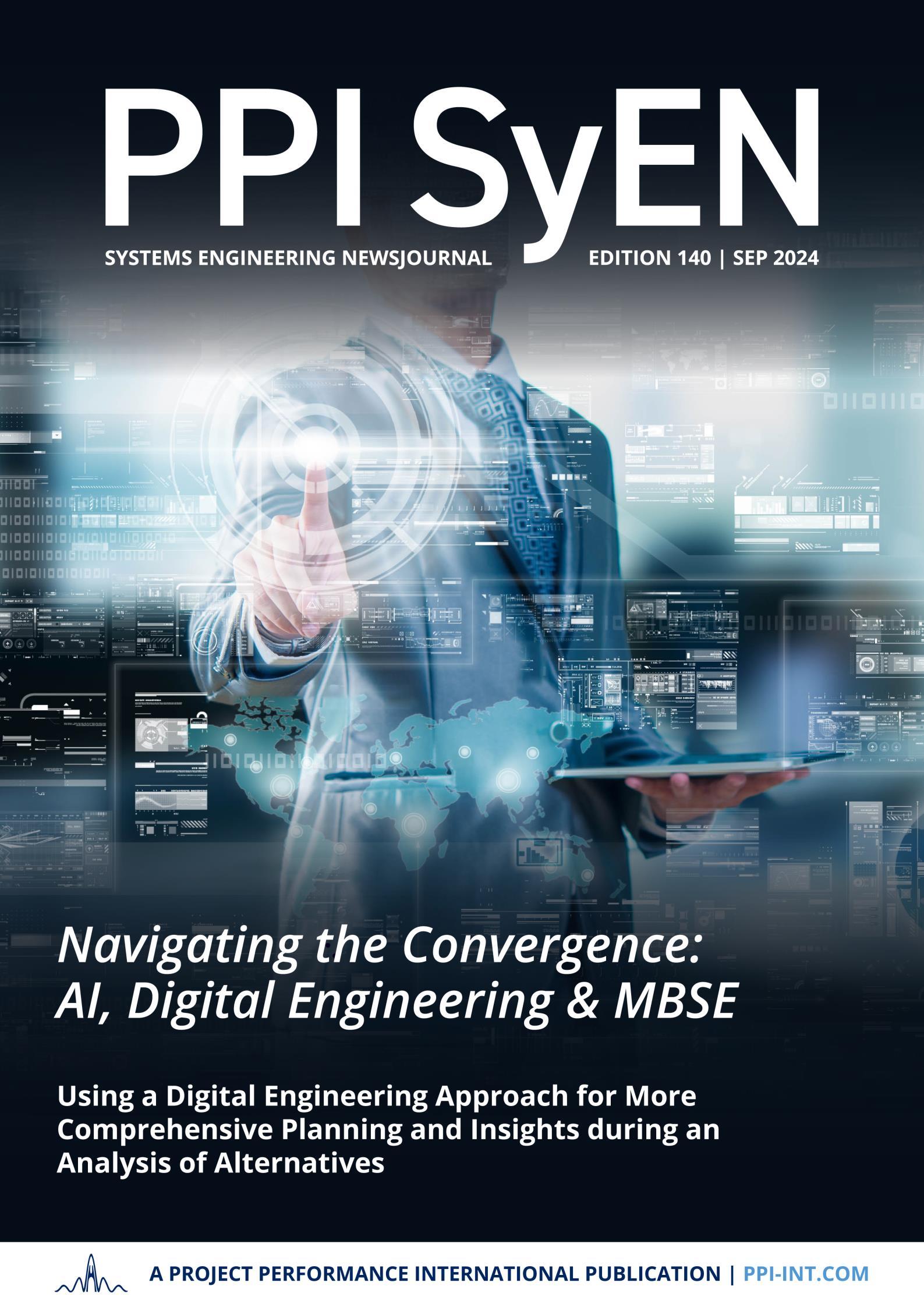

PPI SyEN
EMAIL: PPISyEN@PPI-Int.com


EDITORIAL STAFF
Editor
John Fitch
Editor-in-Chief
Robert Halligan
Managing Editor
René King
PRODUCTION STAFF
Marketing Manager
Benjamin Bryant
Graphic Designer
Matthew Wong
Marketing Coordinator
Rebeca Carneiro
Publishing Assistants
Trudy King
Shalani De Silva
PUBLISHER

Project Performance International
2 Parkgate Drive
Ringwood, Vic 3134 Australia
Tel: +61 3 9876 7345
Tel UK: +44 20 3608 6754
Tel USA: +1 888 772 5174
Tel China: +86 188 5117 2867
www.ppi-int.com
© 2012-2024 Project Performance (Australia) Pty Ltd, trading as Project Performance International
PPI SyEN (PPI Systems Engineering Newsjournal) is published monthly.
Archived editions and subscriptions to future editions are available for free at: https://www.ppi-int.com/syennewsjournal/
WELCOME
Dear Readers,
As the worlds of AI, Digital Engineering, and MBSE continue to converge, we find ourselves navigating uncharted waters. The systems engineering landscape is evolving, and with it, so are the roles of its practitioners. In this month’s edition of PPI SyEN, we explore how this convergence is reshaping our profession, blending cutting-edge technology with age-old engineering wisdom. The theme, Navigating the Convergence: AI, Digital Engineering & MBSE, underscores the challenge and opportunity of integrating these transformative forces.
This edition offers a rich variety of content designed to provoke thought and inspire action. Dr. Vaneman’s feature article sheds light on how MBSE can facilitate the orderly merging of diverse analyses, creating cohesion in the decision-making process. Additionally, the System Dynamics Society 2024 Awards and highlights from the System Mapping Training provide insights into practical applications of systems thinking and engineering tools in this new landscape.
We also feature an exciting spotlight on the Birth of the INCOSE Thailand Chapter, as well as key updates from the INCOSE INSIGHT Practitioners Magazine, which explores the theoretical foundations impacting systems engineering practice today. Meanwhile, our calls for submissions and papers, including the MDPI Systems Journal, emphasize the ongoing challenge of visualizing the convergence of AI, system dynamics, and MBSE where are we headed, and what new questions are emerging?
In this month’s Syenna column, we take a lighter, yet thoughtprovoking approach with ‘Does AI Dream of Systems Engineering Practitioners? exploring the humorous yet serious implications of AI and automation in our field.
As always, I hope you find inspiration in this month’s edition, whether through the academic insights or the practical applications presented. The convergence of AI, DE, and MBSE is not just a trend it’s the future of systems engineering. And together, we have the opportunity to shape it. Wishing you all an insightful and engaging read!
Warm regards,
René Managing Editor
(on behalf of the PPI SyEN team)
By Warren K. Vaneman, Ph.D., ESEP
By Vorachet Jaroensawas, Volunteer at INCOSE Thailand
“
Engineers love to solve problems; those practicing systems engineering love to solve the right problems.
Robert Halligan
PPI Systems Engineering Newsjournal (PPI SyEN) seeks:
➢ To advance the practice and perceived value of systems engineering across a broad range of activities, responsibilities, and job-descriptions
➢ To influence the field of systems engineering from an independent perspective
➢ To provide information, tools, techniques, and other value to a wide spectrum of practitioners, from the experienced, to the newcomer, to the curious
➢ To emphasize that systems engineering exists within the context of (and should be contributory toward) larger social/enterprise systems, not just an end within itself
➢ To give back to the Systems Engineering community
PPI defines systems engineering as: an approach to the engineering of systems, based on systems thinking, that aims to transform a need for a solution into an actual solution that meets imperatives and maximizes effectiveness on a whole-of-life basis, in accordance with the values of the stakeholders whom the solution is to serve. Systems engineering embraces both technical and management dimensions of problem definition and problem solving.

SYSTEMS ENGINEERING NEWS
Recent events and updates in the field of systems engineering
System Dynamics Society 2024 Awards and Conference Highlights
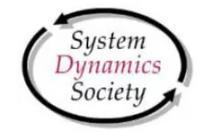
The 2024 International System Dynamics Conference (ISDC 2024) was held on 4-8 August in Bergen, Norway with over 500 in-person and online participants from nearly 60 different countries. The theme of this 42nd anniversary event was Bridging Perspectives for New Insights. The conference was organized around 13 distinct areas of interest.
At ISDC 2024, the System Dynamics Society (SDS) announced a range of awards to organizations and individuals who have contributed to the theory and application of system dynamics and to the advancement of the Society.
The SDS Lifetime Achievement Award recognizes people for making a significant long-term contribution to a field or a practice. The 2024 recipient, Pål Davidsen, has significantly advanced the field of System Dynamics through decades of impactful research, teaching, and institution building. He led the System Dynamics Group at the University of Bergen to excellence and helped foster international collaboration. He also published on an impressive range of topics and held numerous leadership roles within the System Dynamics Society, including serving as President in 2003.
The Outstanding Service Award recognizes individuals for their long-term, exceptional volunteer contributions to the Society. Krys Stave has served as VP Publications and VP Member Services, as well as Associate Editor of the System Dynamics Review (SDR). She’s helped communicate and manifest an inclusive big tent vision of the SDR that better reflects the diversity of work in the field. She’s most recently invested extraordinary efforts as a guest editor to organize a special double issue on qualitative aspects of System Dynamics.
The Dana Meadows Award, recognizing the very best student work in the field, was given to Alexander Kuptel for the paper, co-authored with John Sterman, titled, “Electrifying Away Climate Change: Heat Pumps’ and Retrofits’ Effects on Efficiency, Load, and Emissions in Massachusetts”. Honorable mentions for the Dana Meadows Award included:
• Kian Babaei Shalmani and Catherine DiGennaro“Debiasing Human Response Estimations in Dynamic Models: Exploring the Significance of Delay Structure and Asymmetries”
• Noah Gooijer – “Entity-based System Dynamics for Infrastructure Modeling”
• Daan Bos –“Understanding Expert Perspectives on the Mental Health Care System. Uncovering System Silos with a Participatory Approach”
Ann Osi received the Early Career Health Paper Award for her paper, co-authored with Navid Ghaffarzadegan, “A Simultaneous Simulation of Human Behavior Dynamics and Epidemic Spread: A MultiCountry Study Amidst the Covid-19 Pandemic”. This award recognizes outstanding papers dealing with health-related topics, authored by students or recent graduates.
SYSTEMS
Additional awards included:
• Paco Araujo: Barry Richmond Scholarship Award
• Fatin Aminah Hassan: Honorable Mention – Early Career Health Paper Award
• Ke Zhou, Irene Pluchinotta, Pepe Puchol-Salort, Yuhong Wang, Nici Zimmermann - Best Poster Award (ISDC Attendees Favorite)
See the SDS awards press release for additional details. Learn more about SDS awards, past and present.
PPI SyEN congratulates these award recipients for their contributions to the field of System Dynamics.
PDMA Outstanding Corporate Innovator Awards

The Product Development & Management Association (PDMA) has announced the winners of its 2024 Outstanding Corporate Innovator (OCI) Award. For over three decades, the OCI Award has recognized exceptional organizations that have demonstrated outstanding innovation excellence. The OCI Award selection process identifies companies that consistently generate and harness long-term value through exceptional product and service innovation. Winning companies demonstrate well-defined new product development practices and processes which have contributed to their innovation success.
Two companies were selected as recipients of this year’s honor.
MSA Safety
MSA Safety is a global leader in advanced safety products, technologies, and solutions. Driven by its singular mission of safety, the company has been at the forefront of safety innovation since 1914, helping to protect workers and facility infrastructures across a broad range of end markets. The company’s sustained and quantifiable innovation success is driven by a well-defined business strategy and a culture in which every MSA associate is empowered to deliver against the company’s mission. This includes deploying unique innovation practices that focus on gaining deep customer insights and using the best available technologies to create superior products and solutions that solve customer problems
Dallas Fort Worth International Airport (DFW)
DFW is one of the world’s busiest and most connected airports. With a mission "Travel Transformed" and values that espouse ‘collaboration wins,’ "everyone’s voice matters," and customer-centricity, DFW believes everyone can innovate - or at least contribute to innovation. As such, the concept of the "Everyday Innovator" is at the heart of DFW Airport’s innovation culture.
Paul Puopolo, Executive Vice President Innovation at DFW Airport, states “We started our innovation journey 5 years ago as a team of one and now have a fully integrated innovation program. This is a testament not only to the passion and perseverance of the innovation team members but also the commitment that DFW leadership has provided to the function of innovation.”
Learn more about the OCI award here. Read the PDMA press release.
INCOSE Guide to Security Needs and Requirements (GtSNR) Released
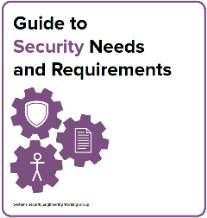
Chapters include:
In August 2024, INCOSE released the Guide to Security Needs and Requirements (GtSNR). Produced by volunteers from the INCOSE Systems Security Engineering (SSE) Working Group, this 28-page document emphasizes a “needs-oriented, lossdriven, capability-based analysis to determine what the system must do to meet stakeholder expectations for a secure system.”
• Introduction
• Security View of Needs, Requirements, Verification, and Validation
• Lifecycle Concepts and Needs Analysis
• Needs to Requirements Transformation
• Requirements Analysis
• Design and System Verification and Validation
• Post Development Verification and Validation
The Guide is available in the INCOSE Store. It is free for INCOSE members with a nominal charge for non-members.
INCOSE Academic Equivalency Agreements

INCOSE has announced the approval of three new Academic Equivalency Agreeements for courses at George Mason University (GMU), Florida Agricultural & Mechanical University (FAMU) and Florida State University (FSU) College of Engineering and Purdue University. Students who do well in university courses assessed to have Academic Equivalence (AcEq) can bypass the certification knowledge exam when applying for ASEP and CSEP Certification. The assessments they complete through their coursework at each university have been recognized by the INCOSE Certification Program’s volunteer reviewers as an equivalent alternative to the standardized test developed by INCOSE.
GMU previously had courses recognized for academic equivalency through their Bachelor of Science in Systems and Industrial Engineering in 2022. As of March 2024, GMU’s Master of Science in Systems Engineering is also recognized as having courses that are equivalent to the certification knowledge exam.
The FAMU-FSU College of Engineering is the only engineering college in the world owned by two universities. The program is a unique partnership between a Historically Black College and University (HBCU) and a Very High Research Activity (R1) Public Institution. The college’s Master’s of Systems Engineering program is the fastest-growing graduate program in the history of the college.
Purdue University has recently updated its courses that qualify students to meet the knowledge requirement for SEP Certification to align with the INCOSE SE Handbook V5.
Learn more about the Academic Equivalency process here and in the Certification Blog.
Visure V8.1 Release

Visure has announced the release of Version 8.1 of the Visure Requirements ALM software. Key enhancements in V8.1 include:
• Baseline Management: Gain complete control over document versions and their electronic signatures.
• Baseline Comparison: Generate MS Word-style redline comparisons between baselines.
• Performance Improvements: Faster handling of an important number of documents with a new description cache
• Review Management: New modern UI for the Review/Approval process to streamline collaboration and communication.
• Test Management: Improved handling of test suites, protocols, plans, and executions.
• Traceability Diagram: Navigate the project traceability through our new traceability diagram.
• Traceability Matrix: Produce complete Requirements Verification Traceability Matrices in a couple of clicks.
For additional details, see the release notes.
Download the product data sheet. View the webinar on Streamlining Requirements Management Processes Learn more about Visure solutions.
Tom Sawyer Software Perspectives 13.1 and Explorations 1.0 Releases

Tom Sawyer Perspectives is a low-code graph visualization and analysis development platform. The recent 13.1 release of Perspectives includes several significant enhancements, including:
Load Neighbors with Advanced Pattern Matching
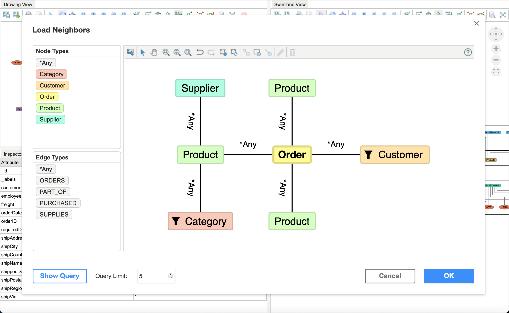
Augmented Centrality
Load Neighbors enables analysts to quickly uncover insights and explore data more easily without the need for knowledge of the Gremlin or Cypher query language. Select one or more nodes, open Load Neighbors, and discover data the is related to your use case through visual graph patterns and conditions on attributes.
Augmented Centrality analysis enables you to customize the algorithm to use a combination of different centrality techniques. Each centrality algorithm has distinct advantages, and augmented centrality allows you to benefit from a combination of these advantages so that can discover more insights in your data.
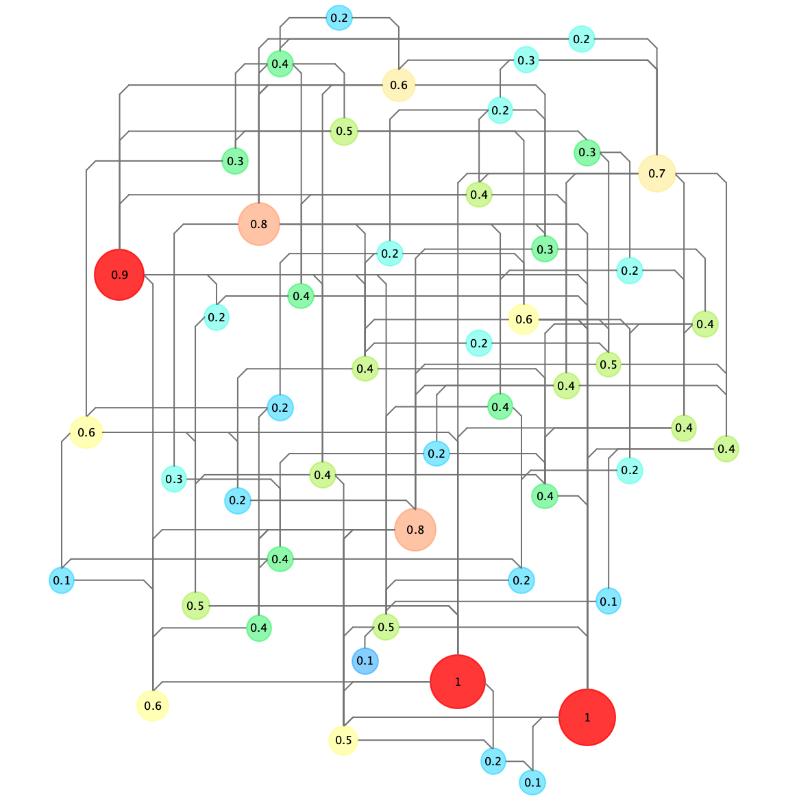
Improved Layout Upon Expansion of Nested Drawings
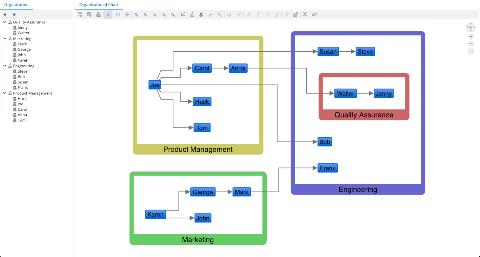
Perspectives now delivers a clearer, more intuitive representation of complex data, making it easier to navigate and interpret your diagrams. These improvements better preserve the user's mental map with refined handling of nested drawings.
Tom Sawyer Perspectives is now available on the AWS Marketplace. This product includes all the capabilities of Perspectives and simplifies the process for developers to create and deploy robust graph visualization and analytics applications in the cloud.
For additional details on the 13.1 release, see the Perspectives release notes and an associated feature overview video
Tom Sawyer Explorations
Tom Sawyer Explorations 1.0 is a new no-code, data exploration platform that empowers analysts of all skill levels to easily connect to a graph database and construct a database query without the need for knowledge of the Gremlin or Cypher query languages. After running the query, Explorations automatically returns the query results in an interactive visualization of the relationships between elements meeting the search criteria enabling a deeper understanding of the complex relationships within the data.
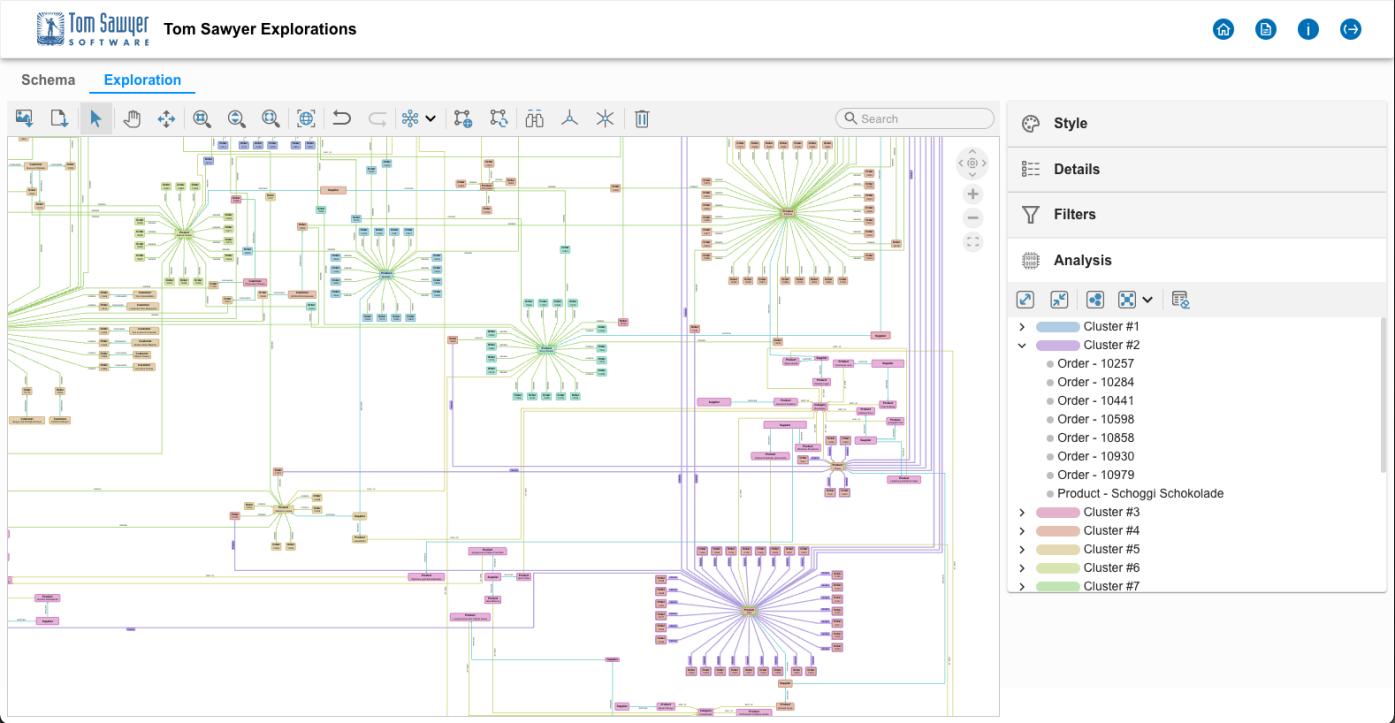
For additional details on the Explorations 1.0 release, see the Explorations release notes and an associated feature overview video
Learn more about Tom Sawyer Software solutions.
Call for Papers: AI in Systems Engineering

INCOSE, through the Wiley online library, periodically
publishes topically focused special issues of the Systems Engineering Journal. A Call for Papers has been released for a special issue titled “AI in Systems Engineering”. The issue will focus on recent advances on how AI can be leveraged in systems engineering, including advanced systems engineering methods towards successfully realizing systems that leverage AI as part of their functionality, performance & behavior.
Cutting edge research, case studies and reviews are sought that highlight the evolution and adoption of AI in systems engineering with topics such as:
• Evolution of AI in Systems Engineering: Historical perspective and future trends.
• AI-Driven Systems Engineering Methods & Practices: Advanced methodologies for integrating AI into systems engineering lifecycle processes, systems design and development, including Model Based Systems Engineering (MBSE).
• Case Studies: Real-world applications and success stories of AI in systems engineering.
• Tools and Frameworks: Development and evaluation of tools and frameworks that facilitate AI integration in systems engineering.
• Impact of AI on System Performance and Behavior: Investigations into how AI influences the reliability, performance, and behavior of complex AI augmented systems.
• AI in SE Lifecycle Management: Enhancing systems engineering lifecycle processes with AI, from concept development to disposal lifecycle stages
• Explainable AI: Advanced methods and SE practices for Explainable AI towards development of intelligent systems that allow humans to understand their assessments, inferences, recommendations and decisions
• Challenges and Opportunities: Ethical and societal implications of AI in systems engineering, including Responsible AI
The deadline for submissions is 1 December 2024.
View the Author Guidelines for the submission process.
Call for Submissions: Integrating System Dynamics with AI and Other Analytical Methods
The mission of MDPI, based in Basel, Switzerland, is to foster open scientific exchange in all forms, across all disciplines. To support this mission MDPI publishes over 100 highly ranked open access journals.

MDPI has issued a Call for Submissions for a special issue of its Systems journal focused on Integrating System Dynamics with AI and Other Analytical Methods. This issue explores the innovative intersection of systemic and analytical methods. In an era where complex challenges are becoming the norm, integrating these methodologies offers new avenues for understanding, modeling, and solving multifaceted problems.
Topics of interest include:
• Theoretical frameworks for integrating system dynamics with AI and machine learning
• Methodological innovations and best practices for integrating systemic and analytical methods
• Theoretical papers discussing the implications of combining system dynamics with AI and machine learning for systems theory and practice
• Empirical studies that employ combined methodologies to solve complex problems in various domains
• Case studies on applying integrated approaches in policy analysis, strategic planning, and decision support
• Methodological innovations and challenges in merging qualitative systemic methods with quantitative analytical techniques
• Critical reflections on the implications of using AI and machine learning within system dynamics for understanding complex systems
• Critical evaluations of the effectiveness and limitations of using system dynamics and analytical methods in tandem
• Methodological innovations for integrating ecological data with systemic models for better environmental policy formulation and prediction
The deadline for manuscript submissions is 28 February 2025. Learn more. Download the special issue flyer Submit abstracts here.
SYSTEMS ENGINEERING
Systems Engineering Tools Database (SETDB) Updates

The Systems Engineering Tools Database (SETDB), developed by PPI in partnership with INCOSE, provides a virtual platform for engineering tool vendors to communicate their latest offerings.
Recent SETDB updates, including both new tools and updates to existing tools, include:
Vendor: Aptech Systems Inc.
• GAUSS Platform: A complete analysis environment with the built-in tools you need for estimation, forecasting, simulation, visualization and more. The GAUSS Platform provides a fully interactive environment for exploring data, performing calculations and analyzing results.
Vendor Hexagon AB
• Cradle CFD: A series of practical, state-of-the-art CFD simulation and visualization software that enables any level users to process advanced simulations. It has been in use for diverse applications to solve thermal and fluid problems.
• scFLOW: Uses unstructured mesh to accurately represent complicated geometry. It is capable of solving aerospace and automotive aerodynamics, performance rotating equipment, design problems of electronic devices, multiphase phenomena, marine propeller cavitation, and varied problems.
Vendor: UL Solutions
• UL 360: CSRD (Corporate Sustainability Reporting Directive) regulation is now mandatory in the European Union and new ESG demand drivers evolving globally, both challenges and growth opportunities also continue to evolve, making ESG excellence a strategic imperative for any forward-thinking organization.
• Supply Chain Network: Enables you to effectively communicate across your entire supply chain - no matter how complex. Gather, analyze and manage product-related data quickly and accurately so you can make critical business decisions that support your business and compliance needs.
• Homer® Front: Provides a powerful online web application that helps you model and optimize the technical and economic performance of utility-scale battery energy storage systems (BESS), solar and wind – independently or as hybrid systems.
• WERCS Studio: Chemical compliance management and enterprise SDS authoring software to manage chemical and material data from development through disposal to meet regulatory requirements, create product transparency and enable safer products.
PPI SyEN readers are encouraged to check out these new and updated systems engineering tool offerings.
Access the SETDB website

CONFERENCES, MEETINGS & WEBINARS
Events of relevance to systems engineering
System Mapping Training

The System Dynamics Society (SDS) is sponsoring the System Mapping Academy’s online, three-session course that will take place on 4, 11 & 18 October. This training is for anyone who wants to learn and explore the potential of System Thinking in a hands-on manner and learn about participatory System Dynamics methods, including group facilitation, Causal Loop Diagrams (CLDs), and Group Model Building (GMB) techniques. Content includes:
• Introduction to Systems Thinking
• Mapping as a visual language for complexity
• How to create meaningful System Maps
• Power of feedback loops to understand system
• System Stories as a basis for collective action
• How to analyze a System Map
• Leverage points to intervene in systems
• Transfer learnings to your work and projects
Intended learning outcomes for this training include:
• Getting an introduction into the world of systems thinking and how to apply it to real-world cases
• Gaining insights into the techniques and processes of system mapping and create your own first map
• Being equipped with the tools and resources you need to transfer your learnings into practice
The course sessions will be conducted from 9 AM – 1 PM Central Europe Time.
Learn more and register here.
Registration fees are reduced for SDS members. Join the SDS.
Webinar: Together We Create - The Power of Integrating Customers Into Your Product Development Black Box

The Carolinas chapter of the Product Development Management Association (PDMA) will host a free webinar on 8 October titled “Together We Create - The Power of Integrating Customers into Your Product Development Black Box”
Led by Jake McKee, this one-hour session will explore a new approach to creating exceptional products: directly engaging the passionate customers who use them. The Community Driven Product Development (CDPD) methodology moves to a more collaborative process with select groups of the
CONFERENCES, MEETINGS & WEBINARS
product's actual users embedded into the product development process. The methodology is based on four big strategic and tactical tasks:
• Finding the right people
• Engaging them at the right time in the development cycle
• Ensuring focus on achieving the right outcomes
• Based on planning and executing the right activities
Learn more and register here.
INCOSE Calling All Systems Webinar - Accelerating MBSE Adoption: Can SysMLv2 Be the Game Changer?

As part of its Calling All Systems series of online events, INCOSE is hosting a panel discussion on 23 October titled “Accelerating MBSE Adoption: Can SysMLv2 Be the Game Changer?”. This panel discussion will explore the potential of SysMLv2 to drive the widespread adoption of Model-Based Systems Engineering (MBSE). Focusing on SysMLv2’s key advancements - enhanced usability, greater precision and expressiveness, and seamless integration – the panel will explore how these features might simplify MBSE processes and address real-world engineering challenges.
Panel participants include noted MBSE experts:
• Daniel Siegl, Business Development at Syntevo GmbH (host)
• Chris Schreiber, Chief Engineer at Lockheed Martin Space
• Daniel Hettema, Director of Digital Engineering, Modeling & Simulation (DEM&S) at the Office of the Under Secretary of Defense for Research and Engineering (OUSD(R&E))
• David Long, President at Blue Holon
• Gan Wang, Vice President, Systems Engineering Ecosystem at Dassault Systemes
• Sandy Friedenthal, Principal Systems Engineer at Lockheed Martin
Learn more about this event. Register here.
Video replays are available for prior panel discussions in the series:
• The Future of MBSE (21 March 2023)
• Product Line Engineering (11 May 2023)
• Sustainability (19 September 2023)
• Models in Space (18 October 2023)
• Complex, Costly, and Challenging: The Science of Resilient Systems (22 May 2024)
NDIA Systems and Mission Engineering Conference

The U.S. National Defense Industrial Association (NDIA) is hosting its 27th Annual Systems and Mission Engineering Conference in Norfolk, Virginia on 28-31 October 2024. This in-person conference targets the U.S. defense community including representatives from industry,
CONFERENCES, MEETINGS & WEBINARS
government, and academia. Typical attendees include Program Managers, Systems Engineers, Chief Scientists and Specialty Engineers/Engineering Managers. The theme of this year’s conference is Digital Transformation across the lifecycle for Mission Success.
Presentation topics span the following areas:
• Actionable Architecture / MOSA Impact
• Artificial Intelligence (AI)
• Digital Engineering and Environments (DEE)
• Education & Training
• Enabling Agile Throughout the Lifecycle
• Mission Engineering / System of Systems
• Model Based Systems Engineering (MBSE)
• Physics-Based Modeling & Simulation and Digital Twin
• Program Management
• Specialty Engineering (Human Systems Engineering)
• Specialty Engineering (Safety and Environmental Engineering (SEE))
• System Security Engineering (SSE)
• Test & Evaluation
Workshops are available on the following topics:
• Digital Materiel Management (DMM) Workshop: Implementing a Digital Technical Review Process
• AI Workshop: Applications of Generative AI with Large Language Models in Aviation and Aerospace
• Industrial Committee on Operational Test and Evaluation
Learn more here. Check out the conference agenda. Register here
Join the NDIA and receive a conference discount.
INCOSE Los Angeles/San Diego One-Day Conference

The INCOSE Los Angeles and San Diego chapters will be jointly hosting an in-person conference on Saturday, 2 December 2023 at the Dassault Systemes Biovia Corp building in Sorrento Valley, San Diego, California, USA.
Keynote:
The keynote talk for this event will be What a Systems Engineer Should Know about Artificial Intelligence by Dr. Rick Hefner, Program Director for the Caltech Center for Technology and Management Education. Dr. Hefner is credited with over 200 presentations and publications, and is a past President of the INCOSE Los Angeles chapter.
As the integration of Artificial Intelligence (AI) continues to reshape industries, including the emergence of ChatGPT, it becomes increasingly important for systems engineers to possess a
CONFERENCES, MEETINGS & WEBINARS
foundational understanding of AI technologies and their implications. This presentation provides a comprehensive overview of the key concepts, challenges, and opportunities that AI brings to the world of systems engineering.
The presentation begins by elucidating the fundamental principles of AI, including machine learning, neural networks, and deep learning. It emphasizes the significance of data in training AI models and explores the spectrum of AI capabilities, from narrow to general intelligence. Recognizing the collaborative nature of systems engineering, the presentation delves into the interdisciplinary aspects of AI integration, shedding light on how systems engineers can effectively collaborate with data scientists and AI specialists to design, develop, and deploy AI-powered systems. Examples from current industry efforts are presented, and the presentation concludes with a discussion of how AI is changing the SE process.
This keynote will equip systems engineers with the knowledge they need to make informed decisions about AI integration within the systems they design and manage, fostering a harmonious synergy between traditional engineering principles and cutting-edge AI technologies.
Check back here to view the evolving program.
Registration is limited to 90 individuals. Register here.
Project World - Business Analyst World Vancouver

The International Institute of Business Analysis™ (IIBA®) is a professional association with over 30,000 members that helps the global business analysis community to achieve better outcomes through better analysis. IIBA® has endorsed the Project WorldBusiness Analyst World conference that will take place in Vancouver, British Columbia, Canada on 4-7 November 2024.
Keynotes for this conference include:
• Dysfunction To Dynamic (Amy Yackowski, Founder & Chief Evolution Officer, Painted Porch Strategies)
• Everything You Need to Know About Artificial Intelligence...But Didn't Know to Ask (James Spellos, President of Meeting U)
• Fry Your Chickens (Phil Barth, PMP, Author, Great Things Happen, LLC)
• Managing Management: The Not-So-Secret Art Behind Enhancing Your Career (Allison Straker, Director, Info-Tech Research Group)
View the detailed conference program here. Workshops will address such topics as:
• Charlie and the Agile Factory
• Hammer it Home! Update your BA Toolbox
• How to Ensure Better Project Decisions when you Feel the Need for Speed
• Strategic Decision-Making for PMs & BAs
CONFERENCES, MEETINGS & WEBINARS
Download the conference brochure
Learn more and register.
Systems Engineering Interoperability Conference

The REUSE Company, in conjunction with INCOSE, CIMdata, and Universidad Carlos III de Madrid is sponsoring the inaugural Systems Engineering Interoperabilty Conference in Madrid, Spain on 13-14 November. The conference’s main objective is to create a space for systems engineering-intensive industry organizations, agencies, and supply chain enterprises to share their interoperability needs and debate different approaches, trends, and goals.
Keynote topics include:
• Interoperability Demands and Needs from the Systems Engineering Discipline
• Interoperability Needs in the Frame of Missions
• Interoperability Needs and Demands in Multinational Space Programs
• Is Interoperability the Silver Bullet for Enabling a Digital Thread?
• Semantic Interoperability: How to Collaborate Between XAF
Planned topics of interest include:
• Collaborative design and interoperability
• Delegated Design (OEM / TIER or TIER /TIER)
• Digital Thread management
• Integration of document-centric and model-based approaches
• Present and Future of Interoperability
• Reuse for Interoperability
• Semantic interoperability
• Technical Management Digitalization as an enabler for interoperability
• Traceability between different information types, requirements, and models
• Unlimited interoperability between heterogeneous Systems Engineering Tools
View the program details. Register here.
Arcadia and Capella Online Training

Obeo is offering an online training course on the Arcadia method and Capella open-source MBSE software, consisting of 6 sessions of 3.5 hours held from 25 November through 5 December. The course will be delivered in English by a Thales MBSE expert, teaching Arcadia/Capella beginners how to effectively use the method and tool.
Course content includes:
• Presentation of the MBSE approach and the Arcadia method
CONFERENCES, MEETINGS & WEBINARS
• General presentation of Capella
• Initialization of a case-study project on Capella
• Implementation of Capella to analyze and model system architectures at different levels (Operational analysis, system analysis, logical architecture, physical architecture, and EPBS)
At the end of the training, participants should be able to:
• Acknowledge the principles, key points, and expected benefits of the MBSE approach
• Describe the steps (perspectives) and the activities of the Arcadia method
• Implement Capella functionalities on a simple case
• Navigate through the different types of support on Arcadia and Capella
Learn more here. Contact Obeo at sales@obeosoft.ca to register.
Call for Submissions: Conference on Systems Engineering Research (CSER 2025)
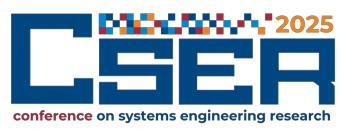
The Conference on Systems Engineering Research (CSER 2025) will be held on 18-21 March 2025 in Long Beach, California, USA. The theme of this event is “Augmented Intelligence in Systems Engineering and Engineered Systems”.
CSER 2025 has issued a Call for Submissions inviting researchers and practitioners to offer contributions that advance the state of the art in systems engineering.
Suggested research topics include:
• Adaptive Cyber-Physical Human Systems
• Agent-Based Simulation
• Cybersecurity Systems Engineering
• Digital Engineering and Digital Twinning
• Generative AI
• Human-AI Teaming
• Interactive Storytelling in Systems Engineering
• Model Based Systems Engineering
• New Topics in Systems Engineering Education
Deadlines:
• Full paper submission: 15 October 2024
• Smart Manufacturing
• Sociotechnical Systems Engineering
• Software-Defined Vehicles
• System Architecture and Complexity
• Systems and SoS Integration
• Systems Thinking and Complexity Management
• Trade-space Visualization and Analysis
• Transdisciplinary Systems Engineering
• XR in Systems Engineering
• Acceptance notification: 15 December 2024
CONFERENCES, MEETINGS & WEBINARS
Call for Contributions: prostep ivip 2025 Symposium

The prostep ivip Association is an independent, solution-neutral, forwardlooking international association committed to developing innovative approaches to solving problems and modern standards for product data management and virtual product creation.
The prostep ivip Symposium 2025 will take place in Berlin, Germany, on 13-14 May 2025. The theme of the symposium is “Revolutionizing Industries with Digital Twins and AI”. A Call for Contributions has been issued for this symposium with a deadline for abstract submission of 6 October 2024.
Topics of interest include:
• Digital Transformation
• AI
• Model-based Systems Engineering
• Digital Twins
• Internet of Things
• Industry 4.0.
See Symposium details here Download the Call for Contributions.
Learn more about prostep ivip here. Subscribe to the Association newsletter.
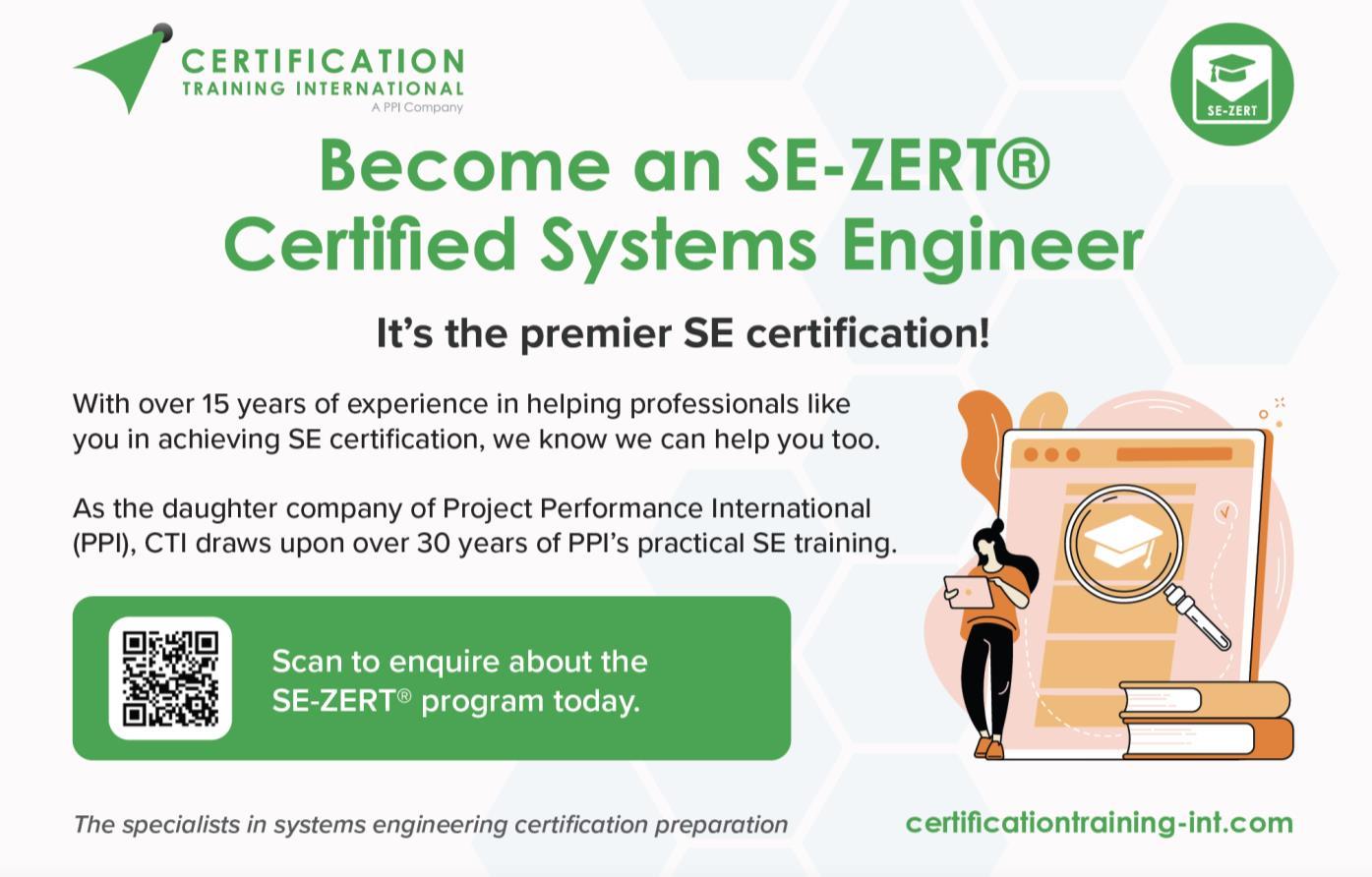
FEATURE ARTICLE Using a Digital Engineering Approach for More Comprehensive Planning and Insights during an Analysis of Alternatives
by Warren K. Vaneman, Ph.D., ESEP
Copyright © 2024 by Warren K. Vaneman. All rights reserved
Authored for PPI SyEN

Abstract
Analysis of Alternatives (AoA) is a means to conduct a comparison of potential system solutions based on operational effectiveness, lifecycle costs, suitability, and risk. Given the wide range of analysis needs, multiple methods, processes, and tools are used to produce data that is ultimately used to make decisions on the alternatives. The methods, processes, and tools can vary widely, leaving the AoA team to “splice together” the disparate data to portray a comprehensive depiction of analysis of the various alternatives. However, just because the data is “spliced together” does not mean the data is correlated. The Systems Engineering Community emphasis on Digital Engineering (DE) has the potential of incorporating, and correlating, data from various system design and analysis processes for a more comprehensive examination of the proposed system. This paper considers the importance of using a foundational ontology, and a meta-model based on a conceptual data model (CDM), to correlate data from various methods, processes, and models to represent the system holistically. The ontology and CDM better aid in the planning for the AoA by depicting how various data supports the analysis and serve as a guide in the selection of analytical methods, processes, and tools that best supports the AoA. This representation allows disparate system data to be correlated, which will facilitate more insightful analysis within the AoA.
Introduction
An Analysis of Alternatives (AoA) is a structured analytic comparison of potential feasible system solutions to address capability needs with respect to system performance, lifecycle costs, risks, and suitability. This multivariate study approach provides decision-makers with the data and information, depicting the strengths and weaknesses of each system alternative, to select the most effective solution as a path forward for the system’s development process. While AoAs are often associated with U.S. Government (particularly Department of Defense (DoD)) acquisition processes (DoDI 5000.2, 2022; DoD 2022; DOE, 2018; USAF, 2017), the concepts are sound systems engineering processes that can, and should, be applied to non-government systems during the early development phases, and on a much smaller scale to trade-off studies during the course of the system’s lifecycle.
FEATURE ARTICLE
Note: While this paper uses the term, “Analysis of Alternatives (AoA),” it is referring to the generic system engineering processes used to conduct an analytic comparison of potential feasible system solutions to address capability needs with respect to system performance, lifecycle costs, risks, and suitability.
Analysis of Alternatives produces multivariant comparisons conducted with various analytic processes, by professionals from multiple disciplines (Systems Engineers, Operations Research Analyst, Cost Analyst, Risk Management Professionals). Given the different disciplines involved analyses are often conducted in an uncoordinated manner, using different data to represent the same system element, and making different, and at time contrary, study assumptions. The analyses yield data at various levels of numerical precision and in formats that are not combined. As a result, the data is collated into an AoA final report in an unplanned, and uncoordinated, manner. If an astute decision-maker were to ask, “Is the reported cost analysis correlated to the system performance being described?” they would likely be surprised with the answer. But there is a solution to this uncorrelated analysis challenge – Digital Engineering!
The Essence of Digital Engineering
The DoD Digital Engineering Strategy defines digital engineering (DE) as “an integrated digital approach that uses authoritative sources of system’s data and models as a continuum across engineering disciplines to support acquisition lifecycle activities from concept through disposal “(DASDE(SE), 2018). Digital engineering is an extension of Model-Based Systems Engineering (MBSE) that integrates engineering data from disparate sources into a digital ecosystem. The DE ecosystem brings together various system lifecycle disciplines to establish a consistent, structured and reusable approach to the way data is created and maintained.
Note: While DE shares many characteristics, principles, and properties with MBSE, MBSE models systems engineering data and often focuses on the use of a single modeling language and modeling tool. DE integrates data from multiple tools and various disciplines.
The fundamental objective of DE is to facilitate a process that consistently leads to the development and analysis of successful systems by representing the system as data from various modeling tools and methodologies. In a DE ecosystem, each entity is represented as data, only once, with all necessary attributes and relationships of that entity being portrayed. This data representation then allows for the entity to be explored from various engineering and programmatic perspectives. The compilation of these perspectives represents the entire system, where the system can be explored holistically or from a single perspective. Figure 1 depicts common AoA engineering and programmatic perspectives superimposed on a dodecagon (D12).
In a document-based ecosystem the various system dimensions are captured by documents, diagrams, and spreadsheets, often with the data being uncorrelated and duplicated. This problem is also true when employing different modeling tools representing uncorrelated data from various perspectives. But the system is only represented once, so why shouldn’t it be modeled that way? True MBSE and DE address the uncorrelated duplicate data by promoting the notion of concordance. Concordance is the ability to represent entity data so that it is consistent across views and abstraction levels (Vaneman, 2016). Thus, the D12 depicted in Figure 1 is a virtual representation of the system where data is represented once, and has the relationships and attributes found in the actual system. For an AoA, there would be a complete model for each alternative.
FEATURE ARTICLE
The DE ecosystem has three characteristics that allow for a more comprehensive and agile engineering and analysis: an authoritative source of truth; formalize the development, integration, and use of models to inform enterprise and program decision-making; and a structure that allows for the data exchange and integration among disparate modeling methodologies, languages, and tools (DASD(SE), 2018).
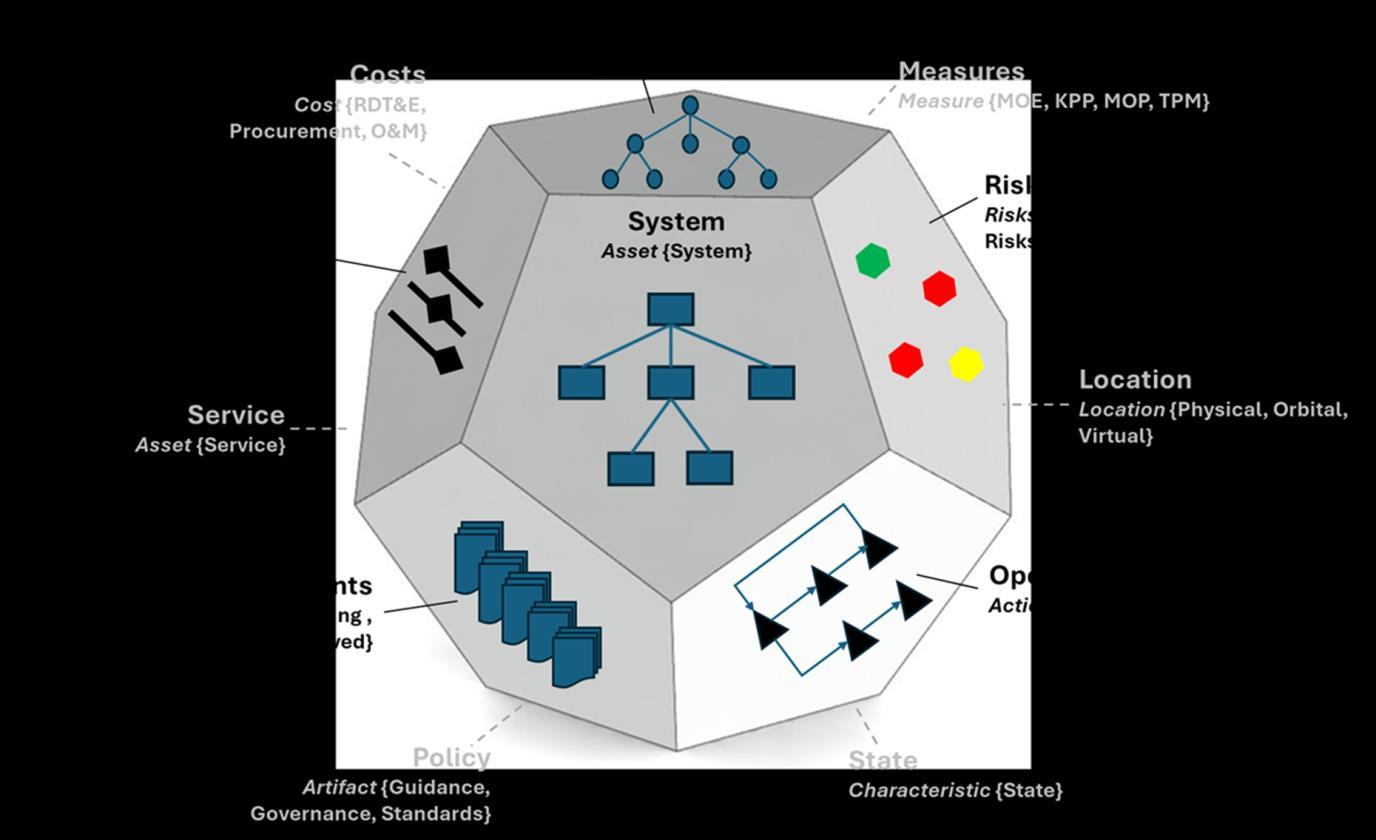
Establishment of an Authoritative Source of Truth for the AoA
A concept that is fundamental to DE is the authoritative source of truth (ASoT). The most credible and trusted sources of data that comprise the ASoT may originate from many different modeling languages, tools, and databases, and can resided in a library-like structure, or stored in its native format, but is shared within a digital ecosystem of tools and databases. (Vaneman, et al., 2023).
Conventional thinking often focuses on the digital artifact as the foundation of the ASoT. However, while bringing digital artifacts together may assure that data from trusted sources are represented in a common or virtual repository, it does not allow for the representation of a comprehensive model and will not likely yield concordance. The ASoT is governed by a foundational ontology that serves as the atomic level of the model. It is from this foundational level where data from different modeling languages, tools, and other sources can be exchanged and combined to achieve concordance.
Given the multiple data types required in an AoA, the ASoT provides the governance needed to establish the virtual representation of the system. Heretofore in an AoA, each engineering and analysis sub-group created models with their own interpretation of the data, resulting in multiple data instances and often conflicting results.
An ontology is essential to data development and management, and is defined as Budin (2005):
Figure 1. Common AoA Engineering and Programmatic Perspectives
FEATURE ARTICLE
“An ontology encompasses a representation, formal naming, and definition of the categories, properties, and relations between the concepts, data, and entities that substantiate one, many, or all domains of discourse. More simply, an ontology is a way of showing the properties of a subject area and how they are related, by defining a set of concepts and categories that represent the subject.”
A basic premise of a foundational ontology is that it should employ an economy of entities approach by reducing seemingly disparate entities from various program data dictionaries to the “atomic level” using a minimal set of entities because having too many entities will introduce ambiguity into the model by using different entities to represent the same thing. Conversely, having too few entities will not fully identify the system elements (Vaneman, et al., 2022).
The Lifecycle Modeling Language (LML) is an example of a foundational ontology that has 12 primary entities and eight sub-entities, and identifies the relationships between entities (LML, 2022). Table 1 shows the LML entities, sub-entities, definitions, and examples (LML, 2022).
Relationships between entities depict how elements with each AoA alternative is connected and interact with each other, allows for the determination of system behavior, and establishes concordance within the model. Each entity has a one-to-many, or many-to-many, possible relationships. These relationships allow for the complexity of the AoA alternatives to be modeled while having a manageable entity and relationship “vocabulary,” at the atomic level. Since most entities are related, total possible combinations for 20 entities approaches 20! or 2.43x1018 combinations. The LML Relationship Matrix (Figure 2) shows the 20 entities and sub-entities and their relationship to each other (LML, 2022).
Formalized AoA Model Development
The ontology is well-suited as a common vernacular for AoA and serves as a foundation for digital data within the various models. While the entities and sub-entities reduce local terms used for an AoA to the atomic level, the approximately 2.43x1018 possible relationships can be overwhelming, since no single AoA is going to use the entire set of combinations. To make the ontology usable, a conceptual data model (CDM) should be developed for the AoA. A CDM is a meta-model that applies and tailors acceptable AoA entities and relationships from the ontology, establishes concordance within the model, and allows for the emergence of system behaviors and performance characterizations. The CDM should be central to developing the AoA study plan, as it guides the development of the virtual representations of the AoA alternatives. The AoA study plan describes how the analysis will be conducted, while the CDM provides a meta-model of how the data used to answer the study questions will come together to form the virtual representation for each alternative. The CDM also identifies where further data exchange standards need to be developed to translate the data between entities that are created in various disparate modeling and analysis tools.
A key component of the AoA study plan is the study questions, which provide insights into system performance, lifecycle costs, risks, and suitability. The study questions should drive the methodology and data needs, and the data needs should drive the meta-model (USAF, 2017). Table 2 shows common AoA questions, the data required to answer those questions, and the entity that the data can be mapped to and serves as the parent for the data.
Note: The relationships are assigned at the entity level, therefore data mapped to the entities have the same relationships through the principle of inheritance.
Entity
Action
Artifact
Asset (Resource)
Characteristic
(Measure)
Connection (Conduit) (Input/Output)
Cost
Decision
Location (Physical)
(Orbital) (Virtual)
Risk
Statement (Requirement)
FEATURE ARTICLE
Table 1. Entities, Entity Definitions, and Examples.
Definition Examples
An Action entity specifies the mechanism by which inputs are transformed into outputs.
An Artifact entity specifies a document or other source of information that is referenced by or generated in the knowledgebase.
An Asset entity specifies an object, person, or organization that performs Actions, such as a system, subsystem, component, or element.
A Resource sub-entity specifies a consumable or producible Asset.
A Characteristic entity specifies properties of an entity.
Time
A Measure sub-entity specifies properties of measurements and measuring methodologies, including metrics.
A Connection entity specifies the means for relating Asset instances to each other.
A Conduit sub-entity specifies the means for physically transporting Input/Output entities between Asset entities. It has limitations (attributes) of capability and latency.
An Input/Output sub-entity specifies the information, data, or object input to, trigger, or output from an Action.
A Cost entity specifies the outlay or expenditure (as of effort or sacrifice) made to achieve an objective associated with another entity.
A Decision entity specifies a challenge and its resolution.
A Location entity specifies where an entity resides.
A Physical sub-entity specifies a location on, above, or below the surface.
An Orbital sub-entity specifies a location along an orbit around a celestial body.
A Virtual sub-entity specifies a location with-in a digital network.
A Risk entity specifies the combined probability and consequence in achieving objectives.
A Statement entity specifies text referenced by the knowledgebase and usually contained in an Artifact
A Requirement sub-entity identifies a capability, characteristic, or quality factor of a system that must exist for the system to have value and utility to the user.
A Time entity specifies a point or period when something occurs or during which an action, asset, process, or condition exists or continues.
Activity, Capability, Function
Policy, Guidance, Governance, Standard
Platform, System, Service
People, Fuel, Supplies
“Ilities” –Usability, Adaptability, Availability, Reliability, Maintainability
Measure of Effectiveness (MOE), Measure of Performance (MOP),
Conduit, Interface, Data Link, Pipe
Data, Information, Energy, Trigger
Actual Cost, Planned Cost, Total Cost
Major Decision, Problem, Resolution, Challenge, Issue
Geospatial coordinates
Ephemeris. Orbit
URL
Cost Risk, Schedule Risk, Technical Performance Risk
Need, Goal, Objective, Assumption
Functional Requirement, Performance Requirement, Safety Requirement
Phase, Milestone, Chronological
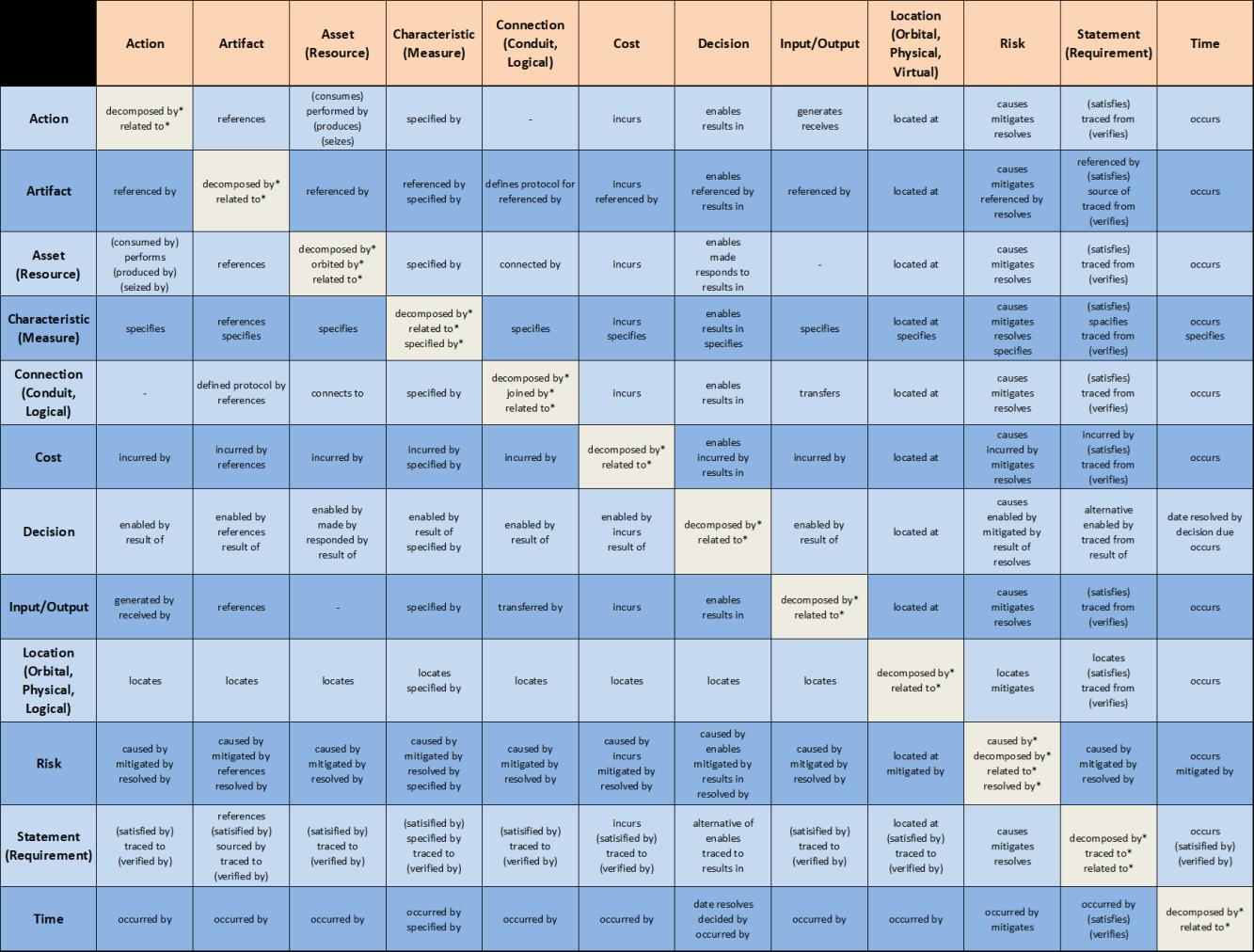
Figure 3 represents a notional CDM of an AoA alternative. The CDM shows five perspectives that represent the various AoA analysis teams. The policy and standards perspective (shown in yellow) operational viewpoint (shown in orange); systems and performance perspective (shown in blue; cost and schedule perspective (shown in green); risk perspective (shown in red); and the decision perspective (shown in orange). Each perspective is composed of Entities, Data, and associated relationships, used to represent the virtual representation of the alternative. Each data representing an element with the alternatives should be modeled as many times as it is represented in the alternative – only once. This modeling approach allows for concordance to be achieved within the model. While the CDM is composed of data at the atomic level, the data could be developed in one or more modeling languages and tools and be portrayed by different presentation frameworks.
The AoA analysis process begins with the definition of need which is usually contained in document that is defined by the Artifact entity. Artifacts (policy, guidance, governance, standard) are inputs to the AoA process, and cannot be changed in the AoA analysis process because they are the “givens.” While the Artifact is the source, the data contained within those courses can be parsed into individual Statements (needs, goal, objective, assumption) which provide the required background, inputs, constraints, and capabilities needed to begin the AoA analysis process.
The Requirements (needs) are traced from the Statements and serve as the source of the capabilities that the alternatives must support. Requirements (needs) are traced to Action (capability). A capability is a solution-neutral statement that specifies what each alternative must achieve a desired
Figure 2. LML Relationship Matrix (LML, 2022)
FEATURE ARTICLE
effect under specified conditions. It is these capabilities that the alternatives will be evaluated against. Action (capability) is related to Action (activity). These activities are central to the operational scenarios as they show the operations within each alternative and provide the sequence and timing. Action (activity) can be further related to Action (function).
Table 2. Common AoA Questions, Data Required, and Mapped Entities
AoA Question
Data Required Entity Requirements and Objectives
What are documents that describe the objectives, goals, and needs for the AoA?
What are the key mission needs?
Policy, Guidance, Standards, Governance
Artifact
Objective, Goals, Needs Statement
What are the capability gaps? Needs, Capabilities Requirement, Action
What key measure will be used to evaluate of the requirements and objectives are met?
What are the feasible alternatives?
Measure of Effectiveness (MOE)
Key Performance Parameter (KPP)
Alternative Solutions
Measure
Systems, Services, Interface, Asset, Connection
What operations do these alternatives perform? Activity, Function, Data, Information Action, Input/Output
Where will the alternatives be located?
Geographical, Orbital, Virtual Location Performance Evaluation
What scenarios will be used to evaluate the alternatives? Activity, Trigger Action, Input/Output
What measures will be used to evaluate the operational effectiveness for each alternative with respect to each scenario?
What is the estimated lifecycle costs for each alternative?
What is the costs break down across research, development, procurement, operations, and disposal phases?
Cost
Measures of Performance (MOP)
Analysis
Measure
Total Ownership Cost Cost
Risk Assessment
What are the technical, operational, and schedule risks associated with each alternative?
Technical, Schedules and Cost Risks Risk
What risk mitigation strategies are available for the alternatives? Problem, Resolution, Challenge, Issue Decision
Sustainability and Supportability
What maintenance will need to be performed on each alternative? Activity Action
What are the logistical needs to support each alternative? Resource Asset
What is the expected lifecycle for each alternative? Time Time
What measures will be used to evaluate how each alternative will be supported?
Reliability, Maintainability, Availability, Suitability Characteristic Schedule and Timeframe
What is the estimated schedule for the development, implementation, and deployment of each alternative?
Schedule, Milestone, Phase Time
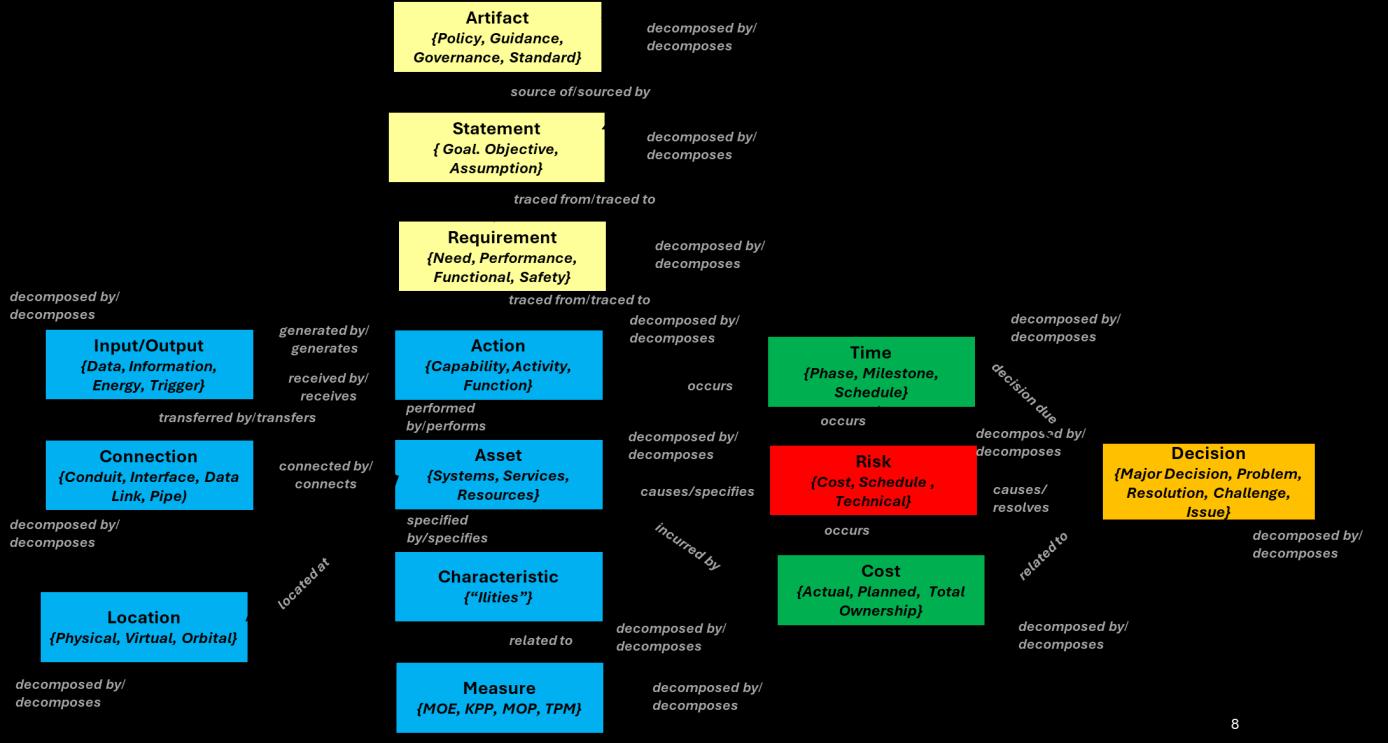
Activities and functions both represent specific actions to achieve the desired objective. The difference is that an activity is associated with the operational steps that are taken, while functions represent what the system is performing. Action (capability, activity, function) generate/receive Input/Output (data, information, energy) from an operational perspective.
Inputs/Outputs are transferred via Connections. Connections provide the interfaces of Assets (systems) to other Assets (systems). The system alternatives are represented by Assets, which are specified by Characteristics which represent qualitative and quantitative “ilities’ (e.g. reliability, maintainability, availability, composability, useability, adaptability). When the Characteristics are quantitative, they can be further defined by Measures (Measures of Effectiveness (MOE), Key Performance Parameters (KPP), Measures of Performance (MOP), and Technical Performance Measures (TPM)). Assets also have a Location (physical, virtual, orbital).
The cost and schedule perspective depict the relationships between Actions and Time (phase, milestone, schedule). Assets incur Cost (actual, planned, total ownership costs). Assets also specify Risks (cost, schedule, technical). These relationships between the Actions, Time, Assets, Costs, and Risks are likely the most significant contribution of DE to the AoA process, because heretofore systems and performance data, and the costs and risks data often lacked formal coordination and collaboration, which resulted in the data being “spliced” together to show the final results.
The AoA decision analysis processes can be performed using Cost, Risk, and Time, and are related to Decision (major decision, problem, resolution, challenge, issue). The strength of these relationships is that there is full traceability or the AoA from the source documentation through the final decision. The CDM provides a meta-model to guide how the entities, and associated data, come together for a virtual representation of the alternatives from all perspectives. Another feature of the CDM is the ability to represent the decomposition for the data, as depicted by the circular arrows on each entity box in Figure 3. The entities can be decomposed at the same rate, while maintaining concordance.
Figure 3. Notional AoA CDM
FEATURE ARTICLE
For example, within the Asset entity a system can be decomposed into sub-subsystems, assemblies, and sub-assemblies, or to the lowest level of decomposition needed to answer the question. While systems can be related to functions (Action entity) and system lifecycle costs (Cost entity), the decomposed sub-system can be related to the corresponding sub-function, and sub-system lifecycle cost. This is a level of analysis that is not typically possible in non-DE AoAs.
Conclusion
Data is essential to models, and models are fundamental to analysis. Digital engineering supports AoAs allowing for better management of engineering models by promoting the formalization of models to inform decision making, provides an enduring authoritative source of truth, and supports collaboration and communication across models. Applying the principles of DE can facilitate better AoAs with an ASoT to consolidate like terms, and data sharing to better collaborate and communicate among the various analysis disciplines. The CDM allows for better data planning, integration, and execution by identifying where relationships between entities exist and areas where data interfaces must be defined. This approach allows for the emergence of system behaviors and performance characterizations that cannot be achieved by interpolating analyses from various discipline-based solutions.
References
Budin, G., "Ontology-driven translation management", in Helle V. Dam (ed.), Knowledge Systems and Translation, Jan Engberg, Heidrun Gerzymisch-Arbogast, Walter de Gruyter, p. 113, ISBN 978-3-11018297-2, 2005.
Department of Defense (DoD). Analysis of Alternatives Cost Estimating Handbook. Washington, D.C., January 2022.
Department of Energy (DOE). Analysis of Alternatives Guidebook. https://www.directives.doe.gov/ Washington, D.C., June 2018.
DoDI 5000.02. Operation of the Adaptive Acquisition Framework. Washington, D.C., June 2022.
Lifecycle Modeling Language Steering Committee. Lifecycle Modeling Language (LML) Specification. Document URL: http://www.lifecyclemodeling.org/spec/1, 2022.
Office of the deputy Assistant Secretary of defense for Systems Engineering (DASD(SE)). Department of Defense Digital Engineering Strategy. Washington, D.C., June 2018.
U.S. Air Force. Analysis of Alternatives (AoA) Handbook: A Practical Guide to the Analysis of Alternatives. Washington, D.C., August 2017.
Vaneman, W. K. Enhancing Model-Based Systems Engineering with the Lifecycle Modeling Language. Orlando, FL: Proceedings of the10th Annual IEEE Systems Conference, April 18-21, 2016.
Vaneman, W.K., R. Carlson, C. White, and R.J. Stone. Developing an MBSE Land domain Construct for Marine Corps Systems Command. NRP Project ID: NPS-22-M254-21. Naval Postgraduate School, Monterey, CA, 2022.
Vaneman, W.K., C. White, R. Carlson, c. Wolfgeher, C. Ritter, G. Rodriguez Melo, and H. Sulca.
FEATURE ARTICLE
Implementing a Model-Based Systems Engineering Land Construct for the Marine Corps. NRP Project ID: NPS-23-M071-A. Naval Postgraduate School, Monterey, CA, 2023.
About the Author
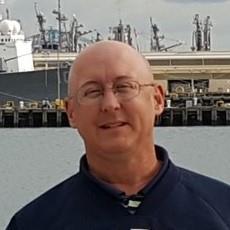
Warren Vaneman has 38 years of leadership and systems engineering experience from positions within the Intelligence Community and DoD and is currently a Professor of Practice in the System Engineering Department at the Naval Postgraduate School, and an adjunct professor at Virginia Tech. He is a retired Navy Reserve Captain, who has a BS from the State University of New York Maritime College, a MS and a Ph.D. in Industrial and Systems Engineering from Virginia Tech. He is certified as an Expert Systems Engineering Professional by the International Council on Systems Engineering (INCOSE).
PPI RESOURCES
PPI offers a multitude of resources available to all our clients, associates and friends! Click on any of the links below to access these resources today.
Systems Engineering FAQ: https://www.ppi-int.com/resources/systems-engineering-faq Industry-related questions answered by PPI Founder and Managing Director Robert Halligan.
Key downloads: https://www.ppi-int.com/keydownloads/
Free downloadable presentations, short papers, specifications and other helpful downloads related to requirements and the field of Systems Engineering.
Conferences: https://www.ppi-int.com/resources/conferences-and-meetings/ Keep track of systems engineering-relevant conferences and meeting dates throughout the year.
Systems Engineering Goldmine: https://www.ppi-int.com/se-goldmine/
A free resource with over 4GB of downloadable information relevant to the Engineering of systems and a searchable database of 7,800+ defined terms. You can expect the content of the SE Goldmine to continue to increase over time.
Systems Engineering Tools Database (requires SEG account to log in from the Systems Engineering Goldmine): https://www.systemsengineeringtools.com/
A resource jointly developed and operated by Project Performance International (PPI) and the International Council on Systems Engineering (INCOSE). The SETDB helps you find appropriate software tools and cloud services that support your systems engineering-related activities. As a PPI SEG account holder, you have ongoing free access to the SETDB.
PPI SyEN Newsjournal (a substantial monthly SE publication): https://www.ppi-int.com/systemsengineering-newsjournal/
You’re already reading our monthly newsjournal! However, click on the link to access the history of 100+ monthly newsjournals containing excellent articles, news and other interesting topics summarizing developments in the field of systems engineering.
PPI SyEN SPOTLIGHT: Birth of the INCOSE Thailand Chapter
By Vorachet Jaroensawas, Volunteer at INCOSE Thailand

Birth of the INCOSE Thailand Chapter
We started with a simple goal, to build friendships and a small Systems Engineering community here in Thailand. It was just a handful of us back in 2015, enthusiasts passionate about bringing SE to life. Progress was slow, I’ll admit. It wasn’t easy to keep the momentum going. But today, I’m excited to share how far we’ve come, and more importantly, where we’re headed. We’re now on the path toward creating something bigger, a Chartered INCOSE Thailand Chapter under the Thailand Systems Engineering Association. It’s been quite a journey, and we’re just getting started!
Let me take you back to 2022, when things really started to change for us. After years of trying to get things off the ground, we got a fantastic opportunity to breathe new life into our chapter. With a fresh wave of support from leaders in engineering and education, we regrouped and reignited the Emerging INCOSE Thailand Chapter. Suddenly, we weren’t just a small community anymore; we were connecting with a broader network of engineers and professionals across the country. It felt like SE was finally gaining traction here in Thailand.
By the end of that year, we received official recognition as an Emerging Chapter within INCOSE’s Asia Oceania Sector III. That was a big deal for us. Since then, we’ve been busy. We’ve hosted meetups, run webinars, and even teamed up with other chapters to share knowledge. And now, we’re preparing for our next big step, hosting the Thailand Systems Engineering Conference (TSEC 2024) in August 2024. We’re really excited to have the support of experts like Dr. Quoc Do, the INCOSE Asia Oceania Director, and Serge Landry, a former Director. Their guidance, along with the contributions from key Thai professionals, has been invaluable.
But, as with any journey, there are still a few bumps in the road. Even though we’ve made great progress, we still have a lot of work to do to get SE fully adopted here in Thailand.
One challenge we’re facing is getting the word out about Systems Engineering. I’m sure you’ve noticed SE isn’t exactly a household name yet. Many Thai engineers are still unfamiliar with it, and we haven’t quite broken through into every sector. Sure, Thai industries like defense and aerospace are starting to see the value, but SE hasn’t yet found its way into the broader engineering community or into university programs. That’s one area we need to push harder to make sure SE becomes part of the core engineering education and that professionals see its real benefits.
We also need to bring more Thai industries on board. SE can do wonders for improving efficiency and reducing risks, but some sectors are still hesitant. If we can show them real-world examples of how SE has made a difference, I think we’ll start to see more adoption. And hey, maybe you’ve got ideas on how to help spread the word. There's room for everyone to get involved in INCOSE Thailand.
PPI SYEN SPOTLIGHT
Speaking of involvement, that brings me to our core team. Building a strong, close-knit team is something we’ve been focusing on. Sure, some chapters wait a while before forming committees, but we feel it’s important to start early. We see this as an incubation phase, a time for our leadership to grow and learn before we apply for Chartered Chapter status in the next few years. This will also help us prepare for the challenges ahead, like organizing conferences and making sure our chapter continues to thrive.
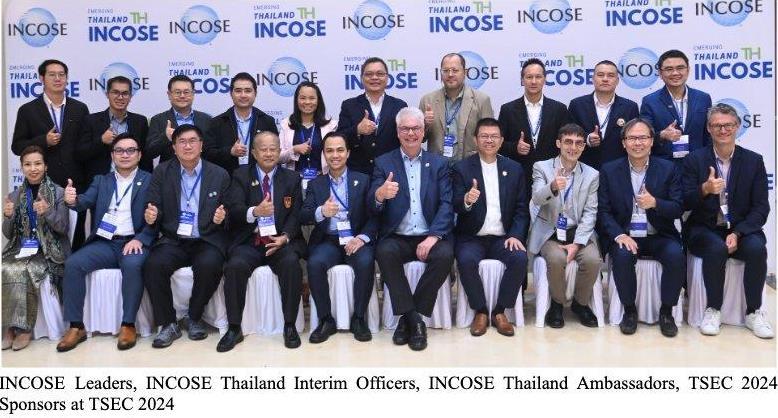
So, what’s next? Well, we are also encouraging new members to join INCOSE, as we need about 25 active members to achieve Chartered Chapter status. It’s an exciting time to get involved - there are so many opportunities to help shape the future of SE in Thailand.
Our vision is to build a strong platform for SE education and community through the Thailand Systems Engineering Association, and we’re working hard to make that a reality. Whether you’re already a member or considering joining, we’d love for you to be part of this journey with us. Let’s make something great together!
SYSTEMS ENGINEERING RESOURCES
Useful artifacts to improve your SE effectiveness

INCOSE INSIGHT Practitioners Magazine: Theoretical Foundations - Impacts on Practice

The August 2024 edition (Volume 27, Issue 4) of INSIGHT, INCOSE’s Practitioner Magazine published by Wiley, has been released. Electronic subscriptions to INSIGHT are available as a member benefit to INCOSE members. Hard-copy subscriptions to INSIGHT are available for purchase by INCOSE members for one membership year, and to the public.
The focus of this issue is INCOSE INSIGHT Practitioners Magazine: Theoretical Foundations - Impacts on Practice. Contents of this 56-page resource include:
Maps or Itineraries? A Systems Engineering Insight from Ancient Navigators by William
D. Schindel
Processes and procedures are the heart of current descriptions of systems engineering. The “vee diagram,” ISO 15288, the INCOSE Systems Engineering Handbook, and enterprise-specific business process models focus attention on process and procedure. However, there is a non-procedural way to view systems engineering. This approach is to describe the configuration space “navigated” by systems engineering, and what is meant by system trajectories in that space, traveled during system life cycles. This sounds abstract because we have lacked explicit maps necessary to describe this configuration space. We understand concrete steps of a procedure, so we focus there. But where do these steps take us? And what does “where” mean in this context? Clues are found in recent discoveries about ancient navigation, as well as later development of mathematics and physics. This paper, part I of a case for stronger model-based systems engineering (MBSE) semantics, focuses on the underlying configuration space inherent to systems.
Got Phenomena? Science-Based Disciplines for Emerging Systems Challenges by
William D. Schindel
Engineering disciplines (civil, mechanical, chemical, electrical) sometimes argue their fields have “real physical phenomena”, “hard science” based laws, and first principles, claiming systems engineering lacks equivalent phenomenological foundation. We argue the opposite, and how replanting systems engineering in model-based systems engineering (MBSE) / pattern-based systems engineering (PBSE) supports emergence of new hard sciences and phenomena-based domain disciplines. Supporting this perspective is the system phenomenon, wellspring of engineering opportunities and challenges. Governed by Hamilton’s principle, it is a traditional path for derivation of equations of motion or physical laws of so-called “fundamental” physical phenomena of mechanics, electromagnetics, chemistry, and thermodynamics. We argue that laws and phenomena of traditional disciplines are less fundamental than the system phenomenon from which they spring. This is a practical reminder of emerging higher disciplines, with phenomena, first principles, and physical laws. Contemporary examples include ground vehicles, aircraft, marine vessels, and biochemical networks; ahead are health care, distribution networks, market systems, ecologies, and the IoT.
SYSTEMS ENGINEERING RESOURCES
Explicating System Value through First Principles: Re-Uniting Decision Analysis with Systems Engineering
by Troy Peterson and William D. Schindel
System complexity continues to grow, creating many new challenges for engineers and decision makers. To maximize value delivery, “both” systems engineering, and decision analysis are essential. The systems engineering profession has had a significant focus on improving systems engineering processes. While process plays an important role, the focus on process was often at the expense of foundational engineering axioms and their contribution to system value. As a consequence, systems engineers were viewed as process developers and managers versus technical leaders with a deep understanding of how system interactions are linked to stakeholder value. With the recent shift toward model-based systems engineering (MBSE), systems engineering is “getting back to basics,” focusing on value delivery via first principles, using established laws of engineering and science. This paper describes how pattern-based systems engineering (PBSE), as outlined within INCOSE’s modelbased systems engineering (MBSE) initiative, explicates system value through modeling of first principles, re-uniting systems engineering and decision analysis capabilities.
Innovation, Risk, Agility, and Learning, Viewed as Optimal Control and Estimation
by William D. Schindel
This paper summarizes how a well-understood problem - optimal control and estimation in “noisy” environments - provides a framework to advance understanding of a well-known but less wellmastered problem - system innovation life cycles and management of decision risks and learning. The ISO15288 process framework and its exposition in the INCOSE Systems Engineering Handbook (2015) describe system development and other life cycle processes. Concerns about improving the performance of processes in dynamic, uncertain, and changing environments are partly addressed by “agile” systems engineering approaches. Both are typically described in the procedural language of business processes, so it is not always clear whether the different approaches are fundamentally at odds, or just different sides of the same coin. Describing the target system, its environment, and the life cycle management processes using models of dynamical systems allows us to apply earlier technical tools, such as the theory of optimal control in noisy environments, to emerging innovation methods.
What Is the Smallest Model of a System?
by William D. Schindel
How we represent systems is fundamental to the history of mathematics, science, and engineering. Model-based engineering methods shift the nature of representation of systems from historical prose forms to explicit data structures more directly comparable to those of science and mathematics. However, using models does not guarantee simpler representation - indeed a typical fear voiced about models is that they may be too complex. Minimality of system representations is of both theoretical and practical interest. The mathematical and scientific interest is that the size of a system’s “minimal representation” is one definition of its complexity. The practical engineering interest is that the size and redundancy of engineering specifications challenge the effectiveness of systems engineering processes. INCOSE thought leaders have asked how systems work can be made 10:1 simpler to attract a 10:1 larger global community of practitioners. And so, we ask: What is the smallest model of a system?
SYSTEMS ENGINEERING RESOURCES
View this issue in the Wiley online library.
System Dynamics Review
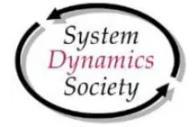
The System Dynamics Review (SDR), published quarterly by Wiley on behalf of the System Dynamics Society (SDS), typically provides non-member access to a select set of journal articles. The recently released SDR Volume 40, Issue 3 contains five open access articles that address how to leverage Artificial Intelligence in system dynamics practice and research.
Developing Model-Based Storytelling to Share Systemic Insights With the Public During the COVID-19 Pandemic
Authors: Daniel Gordon, Ali N. Mashayekhi, Andrada Tomoaia-Cotisel, Hyunjung Kim, Babak Bahaddin, Luis F. Luna-Reyes, and David F. Andersen
Communicating dynamic insights to a wide audience constitutes a long-standing challenge among system dynamics modelers. We propose that telling stories is a compelling way of introducing feedback insights, as well as an understanding of how our individual decisions are linked to social behaviors in our day-to-day living. These decisions often involve moral and ethical trade-offs. In this article, we use examples and heuristics to illustrate how the process of building a system dynamics model can drive a storytelling project. In a complimentary manner, the process of storytelling supports and enriches a model building project by exploring new dynamic hypotheses.
From Text to Model: Leveraging Natural Language Processing for System Dynamics Model Development
Authors: Guido A. Veldhuis, Dominique Blok, Maaike H.T. de Boer, Gino J. Kalkman, Roos M. Bakker, and Rob P.M. van Waas
Textual data is abundantly available, and natural language processing (NLP) facilitates its analysis. However, system dynamics (SD) modelling relies on the modeler to identify relevant information. We explore the ability of NLP models to support SD modelling by identifying causal sentences in texts. We provide a primer on the notion of causality in SD and on the linguistic properties of causality, followed by an introduction of NLP models suitable for this task. Using three test cases, we evaluate the performance of the NLP models using common evaluation metrics and an SD model completeness metric. We conclude that NLP models can add considerable value to SD modelling, provided that remaining challenges are addressed. One such caveat is the difference we observe between information regarded as causal and information relevant for describing system structure. We discuss how these challenges can be addressed through collaboration between the NLP and SD fields.
Generative AI And Simulation Modeling: How Should You (Not) Use Large Language Models Like ChatGPT
Authors: Ali Akhavan, and Mohammad S. Jalali
Generative Artificial Intelligence (AI) tools, such as Large Language Models (LLMs) and chatbots like ChatGPT, hold promise for advancing simulation modeling. Despite their growing prominence and associated debates, there remains a gap in comprehending the potential of generative AI in this field and a lack of guidelines for its effective deployment. This article endeavors to bridge these gaps. We discuss the applications of ChatGPT through an example of modeling COVID-19's impact on economic
SYSTEMS ENGINEERING RESOURCES
growth in the United States. However, our guidelines are generic and can be applied to a broader range of generative AI tools. Our work presents a systematic approach for integrating generative AI across the simulation research continuum, from problem articulation to insight derivation and documentation, independent of the specific simulation modeling method. We emphasize while these tools offer enhancements in refining ideas and expediting processes, they should complement rather than replace critical thinking inherent to research.
Integrating AI Language Models in Qualitative Research: Replicating Interview Data Analysis With ChatGPT
Authors: Mohammad S. Jalali, and Ali Akhavan
The recent advent of artificial intelligence (AI) language tools like ChatGPT has opened up new opportunities in qualitative research. We revisited a previous project on obesity prevention interventions, where we developed a causal loop diagram through in-depth interview data analysis. Utilizing ChatGPT in our replication process, we compared its results against our original approach. We discuss that ChatGPT contributes to improved efficiency and unbiased data processing; however, it also reveals limitations in context understanding. Our findings suggest that AI language tools currently have great potential to serve as an augmentative tool rather than a replacement for the intricate analytical tasks performed by humans. With ongoing advancements, AI technologies may soon offer more substantial support in enhancing qualitative research capabilities, an area that deserves more investigation.
Preparing for Pandemic Response in the Context of Limited Resources
Authors: Jair Andrade, Berend Beishuizen, Mart Stein, Máire Connolly, and Jim Duggan
Pandemics are outbreaks of an infectious disease that increase morbidity and mortality over a wide geographic area. These events require large-scale interventions from governments and health agencies to curtail transmission within a population. In assessing the impact of these interventions, policymakers avail themselves of simulations from compartmental models. However, it is commonplace that modelers employ fixed fractions to represent interventions, which implicitly assume that resources instantaneously and boundlessly adjust to the desired target and may predict overly optimistic outcomes. Here, we propose a model that integrates four crucial countermeasures subject to resource constraints. We present this structure utilizing the concept of small models and frame the simulations in the context of a hypothetical spread of influenza in the Netherlands, drawing on empirical data. After incorporating resource constraints, we find that only a comprehensive response controls the disease. These findings highlight the need for improving strategic plans to support pandemic preparedness.
This issue of the SDR adds members-only content including:
• A Complete Shortest Independent Loop Set Algorithm for Model Structure Analysis by Serafina Middleton, and Mohammad Motamed
• From Text To Map: A System Dynamics Bot For Constructing Causal Loop Diagrams by Niyousha Hosseinichimeh, Aritra Majumdar, Ross Williams, and Navid Ghaffarzadegan
• The Lowly Constant, Elevated by Leonard A Malczynski
• Using System Dynamics to Support a Functional Exercise For Pandemic Preparedness and Response by Caroline Green, Berend Beishuizen, Mart Stein, Chantal P. Rovers, Alma Tostmann, Daan L. K. de Jong, Claudia Houareau, Knut Perseke, Clara Spieker, Ulrike Grote, Patrick Csornai, Carlos Tighe, Conor Hayes, Jair Andrade, Máire A. Connolly, and Jim Duggan
SYSTEMS ENGINEERING RESOURCES
Learn more about the System Dynamics Review here. Join the SDS to gain full access to the System Dynamics Review.
INCOSE Systems Engineering Journal September 2024 Edition

In September 2024, INCOSE, through the Wiley online library,
published Volume 27, Issue 5 of the Systems Engineering Journal. This edition includes nine articles, a mix of open access and full access papers that require an institutional login, e.g., via INCOSE membership. There is no published unifying theme for this edition. PPI SyEN has included abstracts to guide our readers to which of these diverse topics best fit their interests.
Open Access Articles
Open Access articles are available to view and download in PDF format without any restrictions.
Bacterial chemotaxis control process analysis with SysML
Author: James D. Johansen
Abstract: This paper looks at the bacteria chemotaxis control process utilizing the System Modeling Language (SysML) to leverage well-defined and proven engineering tools for architecting, analyzing, and refining complex systems. It proposes a new methodology called reverse-engineering objectoriented systems engineering method (RE-OOSEM) that converts descriptive biology research information into descriptive systems engineering information. It utilizes SysML and model-based systems engineering (MBSE) to capture system architecture from biological system knowledge and inputs them into systems engineering tools. From an engineering point of view, this allows greater insight into how biological systems operate and suggests how much model detail is required to uncover a top-down system understanding. RE-OOSEM methodology guides the SysML chemotaxis control capture process. SysML syntax is used instead of biological syntax to facilitate biological chemotaxis control system analysis from an engineered system point of view. The model can act as a scaffolding to help uncover system function, the relationships of system components and processes, and bioinformatic phenotype and genotype correlation. An executable MathWorks Stateflow chemotaxis control process model based on the SysML architectural model is included. The results show the following engineering perspective observations. (1) Several control components are not dedicated but are available and utilized when needed. (2) Individual chemoreceptors act together as a sensor array. (3) Phosphate groups act as a signaling mechanism. (4) Methylation via CH3 groups of the chemoreceptor results in sensitivity adaptation. (5) Closed-loop control collaboratively utilizes ligand bonding, phosphorylation, and methylation. (6) Timing relationships of the control subprocesses give insight into the system's architecture.
Bio-inspired human network diagnostics: Ecological modularity and nestedness as quantitative indicators of human engineered network function
Authors: Samuel Blair, Garrett Hairston, Henry Banks, Claire Kaat, Julie Linsey, and Astrid Layton
Abstract: Analyzing interactions between actors from a systems perspective yields valuable information about the overall system's form and function. When this is coupled with ecological
SYSTEMS ENGINEERING RESOURCES
modeling and analysis techniques, biological inspiration can also be applied to these systems. The diagnostic value of three metrics frequently used to study mutualistic biological ecosystems (nestedness, modularity, and connectance) is shown here using academic engineering makerspaces. Engineering students get hands-on usage experience with tools for personal, class, and competitionbased projects in these spaces. COVID-19 provides a unique study of university makerspaces, enabling the analysis of makerspace health through the known disturbance and resultant regulatory changes (implementation and return to normal operations). Nestedness, modularity, and connectance are shown to provide information on space functioning in a way that enables them to serve as heuristic diagnostics tools for system conditions. The makerspaces at two large R1 universities are analyzed across multiple semesters by modeling them as bipartite student-tool interaction networks. The results visualize the predictive ability of these metrics, finding that the makerspaces tended to be structurally nested in any one semester, however when compared to a “normal” semester the restrictions are reflected via a higher modularity. The makerspace network case studies provide insight into the use and value of quantitative ecosystem structure and function indicators for monitoring similar human-engineered interaction networks that are normally only tracked qualitatively.
Mission-based design of UAVs
Authors: Jean-Charles Chaudemar, Ombeline Aïello, Pierre de Saqui-Sannes, and
Olivier Poitou
Abstract: Over the past decades, Unmanned Aerial Vehicles (UAVs) have increasingly been used in a wide variety of missions that range from surveillance to delivery. Unlike aircraft that always carry goods and passengers from an airport to another, UAVs do not systematically implement the same type of mission. UAVs are indeed multi-mission during their time in operation, and the systems engineering approaches developed for one mission aircraft must be adapted to the multi-mission context. Therefore, UAV design requires application of mission engineering upstream systems engineering, either to assess there is a UAV system that may accomplish a new mission, or to specify a new UAV system according to a given mission. To achieve that goal, the authors of the paper support the use of Model-Based Mission Engineering. A three-layer architecture - purpose, operation, functions or capabilities - is proposed as a design framework for missions. The Goal-Oriented Requirements Language (GRL) serves as mission description language.
The paper extends GRL to better address mission-based design of UAVs. It is proposed to distinguish between internal and external resources. A goal detailing mechanism is introduced. A degraded mode evaluation becomes possible. GRL tools make it possible to evaluate how much a UAV system - at least, an operator, a ground station, and a UAV - may satisfy every stakeholder in both nominal and degraded modes. The proposed approach is applied to a high voltage surveillance UAV. The case study enables the introduction of four actors - Authority, Client, UAV and MissionSupervisor - that turn out to be generic and can be reused for other missions and UAV designs.
PRODEC for human systems integration of increasingly autonomous systems
Authors: Guy André Boy, Dimitri Masson, Élise Durnerin, and Chloé Morel
Abstract: The purpose of the PRODEC scenario-based design method is the incremental crossfertilization and refinement of procedural scenarios and declarative configurations. It uses virtual prototypes of the developed systems (mainly life-critical systems) to conduct human-in-the-loop simulations (HITLSs). Based on human systems integration (HSI) principles and criteria, as well as expertise and experience in the domain at stake, this HSI approach grounded in virtual environments requires a clear definition of physical and cognitive tangibility metrics to assess the distance between
SYSTEMS ENGINEERING RESOURCES
virtual and tangible (grasp) dimensions of the system being developed when it is put to work. PRODEC considers human and machine systems described in terms of structures and functions incrementally designed using procedural scenarios (i.e., stories) in task and activity networks, which provide life to declarative configurations (i.e., system's functions and structures). This active modeling and simulation process enables the discovery of emergent structures and functions of the system being developed when it is virtually operated. PRODEC's use is illustrated in an example. We discuss the use of PRODEC and its results as to how they can be used with digital twins.
Systematic application of traffic-signal-control system architecture design and selection using modelbased systems engineering and Pareto frontier analysis
Authors: Ana Theodora Balaci, Eun Suk Suh, and Junseok Hwang
Abstract: The global population rise has increased vehicles on roads, complicating traffic management. Inefficient traffic control systems cause significant economic losses owing to commuter time wastage, high energy consumption, and greenhouse gas emissions. Traffic signal control systems (TSCSs) are vital in traffic management, impacting traffic flow significantly; therefore, studies are exploring new optimization approaches that adapt to changing traffic conditions. However, they concentrate on either new technology infusion or on control algorithm optimization, and do not holistically address the architectural configuration of the system. In this study, we presented a unique case study by applying an existing systematic framework to the TSCS system architecture design and selection process. This application demonstrates that TSCS enhancement is a multifaceted process that requires a comprehensive assessment of not only technical aspects, such as the control algorithm, but also factors including system architecture, security, and data integrity. Because of the increasing reliance of TSCSs on data exchange between their various subsystems, this case study also adopted a cybersecurity perspective of the system and introduced cyber resiliency as a crucial metric for evaluating TSCS architecture performance. Furthermore, through the applied framework, an optimal TSCS architectural configuration with executable options was identified by generating multiple TSCS architectural configurations using decision option patterns and identifying those on the Pareto frontier to understand the architectural decision-making process. Traffic engineers and transportation planners can use this case study application as a guide to optimize TSCSs employed in existing transportation networks and design more efficient transportation networks for future urban development.
The evolution of systems engineering as a transdiscipline
Authors: Michael Pennotti, Peter Brook, and David Rousseau
Abstract: Systems engineering's evolutionary trajectory has been far from linear, and its future direction is uncertain. We present an assessment and vision of how SE might evolve to enduringly be impactful and relevant, despite growing complexity and radical technological change. We discuss how SE started out focused on achieving technical objectives, then drifted towards a more process and methodology focus, and is now responding to calls to return to its roots under the banner of “attaining elegant solutions to complex problems.” We discuss how SE has always been a transdiscipline, although it was not always so recognized, and how SE is now increasingly recognizing and valuing its transdisciplinary nature. We present our view that the future of SE as an impactful and relevant engineering discipline lies in the strengthening of its transdisciplinarity and an increased focus on attaining elegant solutions to complex problems. We present a framework for understanding the nature of SE and the way in which it evolves in terms of its principles, methods and purposes. We show that SE is informed by and informs many disciplines and social institutions in a dynamic ecology of discovery, achievement, and vision. Lastly, we discuss the value of this framework, and show how it
SYSTEMS ENGINEERING RESOURCES
can serve as a basis for developing a common understanding of the value and potential of SE, and support institutions such as INCOSE as they engage in the wider social agenda of building a better and more sustainable world.
Using functional decomposition to bridge the design gap between desired emergent multi-agentsystem resilience and individual agent design
Authors: Isabella Hernandez, Bryan C. Watson, Marc J. Weissburg, and Bert Bras
Abstract: Increasing the resilience of modern infrastructure systems is recognized as a priority by both the International Council on Systems Engineering and the National Academy of Engineering. Resilience answers the key stakeholder need for a stable and predictable system by withstanding, adapting to, and recovering from unexpected faults. Increasing resilience in multi-agent systems is especially challenging because resilience is an emergent system-level property rather than the sum of individual agent functions. This paper uses biological systems as a source of inspiration for resilient functions, examining the central question How can biologically inspired design be used to increase the emergent property of resilience in multi-agent systems?
The paper uses functional decomposition to break down the individual functions that result in resilience and transfer the properties to generalized systems. Accordingly, the central hypothesis examined in this article is If functional decomposition is performed on eusocial insect colonies, then generalizable approaches to increase the emergent property of multi-agent system resilience can be identified. The results provide two contributions. The first contribution is the identification of six general functions based on eusocial insect behavior that influence resilience. The second contribution is a description of the process of identifying and transferring insect behaviors into generalized designfor-resilience guidance. To support these contributions, a case study applies biologically inspired functions to an emergency power service system and proposes tactics for the power system to improve its resilience. Thus, this article provides a key step towards our goal of using biologically inspired design to influence the emergent property of resilience in multi-agent systems.
Full Access Articles
Full Access articles are available through an institutional login such as INCOSE membership.
DTFL-DF: Digital twin architecture powered by federated learning decision forest to mitigate fire accidents in mining industry
Authors: Udayakumar Kamalakannan, Ramamoorthy Sriramulu, and Poorvadevi Ramamurthi
Abstract: Automation is the guiding principle of this new era, and despite the problems that humanity faces as a result of automation, technology has greatly benefitted people by streamlining challenging jobs across many industries. The mining business, where there are frequently unforeseen mishaps, is one such industry that requires complete automation. In this work, a new simulative processing environment termed DTFL-DF Digital twin federated learning decision forest a digital twin environment that is tailored to handle unforeseen fire incidents is offered as a means of avoiding these unplanned catastrophes in the mining industry. Although the design presented here is intended for usage in the mining sector, it can also be applied to other sectors. The overall technological contribution of this study is to guarantee the processing of real-time data in order to successfully handle mission-critical operations without relying on past data. This is accomplished by adapting the digital twin's original design and distributing the processing environment within the edge-fog layer. Results analysis in the form of robustness analysis, performance evaluation of the classification model, etc. provides strong support for the suggested methodology. For handling the decentralized
SYSTEMS ENGINEERING RESOURCES
training procedure, a brand-new algorithm termed FL-DF is put forth in order to speed up classification and prevent any sort of catastrophe.
Requirements engineering in industry 4.0: State of the art and directions to continuous requirements engineering
Authors: Leonardo Vieira Barcelos, Pablo Oliveira Antonino, and Elisa Yumi Nakagawa
Abstract: The 4th Industrial Revolution, also known as Industry 4.0, intends to transform manufacturing processes into smart factories with full digitalization and intelligent, decentralized, and flexible production. In this scenario, Industry 4.0 systems (i.e., software-intensive systems that automate smart factories) have required rigorous and continuous development, but smart factory companies often have difficulty dealing with Requirements Engineering (RE) where requirements continuously change and emerge at runtime to support the changeability of complex production processes. Such requirements encompass engineering (e.g., mechanical, electrical, electronic, production/manufacturing) and business areas and involve the vertical and horizontal integration of heterogeneous manufacturing systems. There is also a lack of a panorama of how Industry 4.0 projects have performed with RE activities. The main goal of this paper is to present the state-of-theart research concerning RE in Industry 4.0 and draw attention to the next most urgent steps. For this, we selected and examined studies that address RE for Industry 4.0, noting that much of this literature is recent but does not fully address the complexity and dynamism of the requirements for Industry 4.0. Grounded on these studies and our academic and industry experience, we highlight the need for Continuous Requirements Engineering (CRE) for Industry 4.0.
INCOSE members in good standing may access all Systems Engineering Journal content through their INCOSE Connect login (using the Wiley Online Proceedings Library link after login). Non-members may subscribe to the journal, use institutional logins from their university or place of employment, or purchase access to individual articles at the URLs associated with the article titles, above.
Case Study: Practical Application of Agile MBSE to Intelligent Transportation Systems
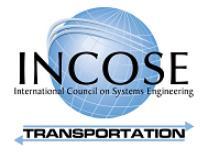
The INCOSE Transportation Working Group (TWG) maintains a productive collaborative relationship and conducts regular meetings with numerous other organizations, including the American Public Transportation Association (APTA) and the INCOSE UK Railway Interest Group (RIG). These collaborations have generated a rich set of resources made available in the TWG’s YouTube channel
On 20 August 2024, these organizations shared a presentation titled “Practical Application of Agile MBSE to Intelligent Transportation Systems”. This case study described the practical and successful introduction of Agile Model-Based Systems Engineering (MBSE) to the design, implementation, integration, and testing of a complex, multi-agency, multi-modal, and multi-purpose Intelligent Transportation System (ITS) project, implementing the Federal Highway Administration (FHWA) guidelines as described in the “Applying Scrum Methods to ITS Projects” report.
Other recent TWG-APTA-RIG topical videos are available such as:
• A Systems Approach to Project Delivery. Is it wishful thinking?
• Engineering Option Appraisal at Network Rail: A Review and Proposal
SYSTEMS ENGINEERING RESOURCES
• ESI Assurance (Engage, Synchronise, Integrate) – Future Proofing Engineering Assurance for High Integrity System Development
• Improving Technology Procurement and Reducing Risk
• Lessons Learned and Recommendations for the Application of Systems Engineering as an Emerging Discipline in Transportation & Infrastructure Projects
• Systems Approach to Sustainable Transport and Mobility Solutions
Learn more about TWG and its many resources.
Smart Cities Council Podcasts
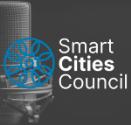
The Smart Cities Council (SCC) hosted two recent podcasts relevant to smart cities strategies, technology and application experience. PPI SyEN readers are encouraged to check out these resources and the systems challenges that they highlight.
When Power Fails, How Will We Communicate?
Join us on the Smart Cities Council's Global Thought Leadership Team podcast series, featuring global experts driving policy, research, and standards in smart city innovation. In this episode, Fanni Melles interviews Bobby Perkins, the global thought leader for 5G and digital infrastructure, to discuss the challenges and opportunities of network transport, wireless communications, and sustainable infrastructure. They explore the critical role of resiliency, especially during power outages, and the importance of collaborative efforts between academia, industry, and government to create sustainable, smart cities.
Key takeaways include:
• Imagine a World Without Power
• 5G & Smart Cities: What's the Connection?
• Network Transport: The Backbone of Connectivity
• Predicting the Future of Tech
• Bobby's Journey Towards Digital Trust
• Is Humanity's Mission to Become Sustainable?
• Seizing Opportunities in 5G and Digital Infrastructure
• Tech Inclusion: Reaching Beyond the Norm
• Wireless Technologies and Space Exploration
• New to 5G and Digital Infrastructure? Start Here!
Can Generative AI Transform Public Safety and Smart Cities?
In this episode of the Smart Cities Council podcast, host Fannie Meles sits down with Steve Circon, a former chief of police and the president of Safe Cities Global. Steve shares his insights on the transformative impact of AI and generative AI in public safety and smart city initiatives. Drawing from his extensive experience in law enforcement and public safety technology, Steve discusses the biggest challenges and opportunities in the field, emphasizing the critical role of community involvement and advanced technological solutions. Tune in to learn how AI is revolutionizing public safety and what the future holds for smart cities.
Key takeaways include:
SYSTEMS ENGINEERING RESOURCES
• Unlocking the Potential of Public Safety: What’s Ahead
• Defining Public Safety in the Age of Smart Cities
• The Essence of Smart Cities: Steve’s Perspective
• Safety vs Security: What’s the Real Difference?
• Who Bears the Responsibility for Safety and Security?
• Overcoming Hurdles in Public Safety
• Seizing Opportunities in Public Safety
• Navigating Public Safety Enforcement and Digital Trust
• Balancing Optimism and Concerns About Tech in Public Safety
• Getting Started: Tips for Diving into Public Safety
Learn more about the Smart Cities Council here.
Digital Twin Consortium (DTC) Publications

The Digital Twin Consortium (DTC) has been building up a library of publications and white papers that provide de facto best practices, standards requirements, and technical foundations across the digital engineering landscape.
Topics addressed in this growing library include:
• Applying Reality Capture to Site Civil Projects
• Applying Reality Capture to Tenant Improvement Projects
• Assuring Trustworthiness in Dynamic Systems Using Digital Twins and Trust Vectors
• A Whole Systems Approach to Decarbonization Across the Building Lifecycle
• Decarbonizing Buildings with Digital Twins: Identifying and Aligning the Stakeholders
• IoT Security Maturity Model for Digital Twins
• Reality Capture: A Digital Twin Foundation
• The Platform Stack Architectural Framework: An Introductory Guide
• Why Sustainability for Buildings?
View other DTC resources here.
Learn more about the DTC’s Architecture, Engineering, Construction & Operations (AECO) Working Group.
FINAL THOUGHTS FROM SYENNA

"Does
AI Dream of Systems Engineering Practitioners? Navigating the Rise of the Digital Overlords in Engineering"
As artificial intelligence continues its rapid rise, systems engineering practitioners may find themselves asking: "Are we building the future, or is it building us?" In a world where AI, Digital Engineering, and MBSE are converging, the role of the human practitioner is evolving in ways both exciting and, at times, slightly unsettling. AI isn't just a tool anymore it’s becoming an integral part of the design process, taking on tasks that once required human intuition and expertise. But does AI truly understand the complexity of systems engineering, or are we merely teaching it to mimic our best practices without ever really ‘dreaming’ in the way we do?
This convergence of AI and engineering disciplines is creating a new dynamic where systems engineering practitioners are part visionary, part collaborator with their digital counterparts. The allure of AI-driven insights and automation promises to streamline processes, make decisions faster, and reduce human error but at what cost? As we hand over more control to intelligent algorithms, there’s an emerging question of whether we are leading the charge or if the systems we’ve engineered are beginning to guide us.
Will there come a time when AI begins to generate systems designs on its own, leaving us to merely approve or tweak them? Or perhaps, more provocatively, are we teaching AI to think like systems engineering practitioners, only to find that the complexity of human judgment, creativity, and adaptability can never fully be replicated? Either way, as we navigate this convergence, one thing is clear: AI may never dream, but it’s certainly making systems engineering practitioners dream bigger and maybe a little weirder about the future of their craft.
Regards, Syenna
“
A factor present in every successful project and absent in every unsuccessful project is sufficient attention to requirements.
Suzanne & James Robertson
